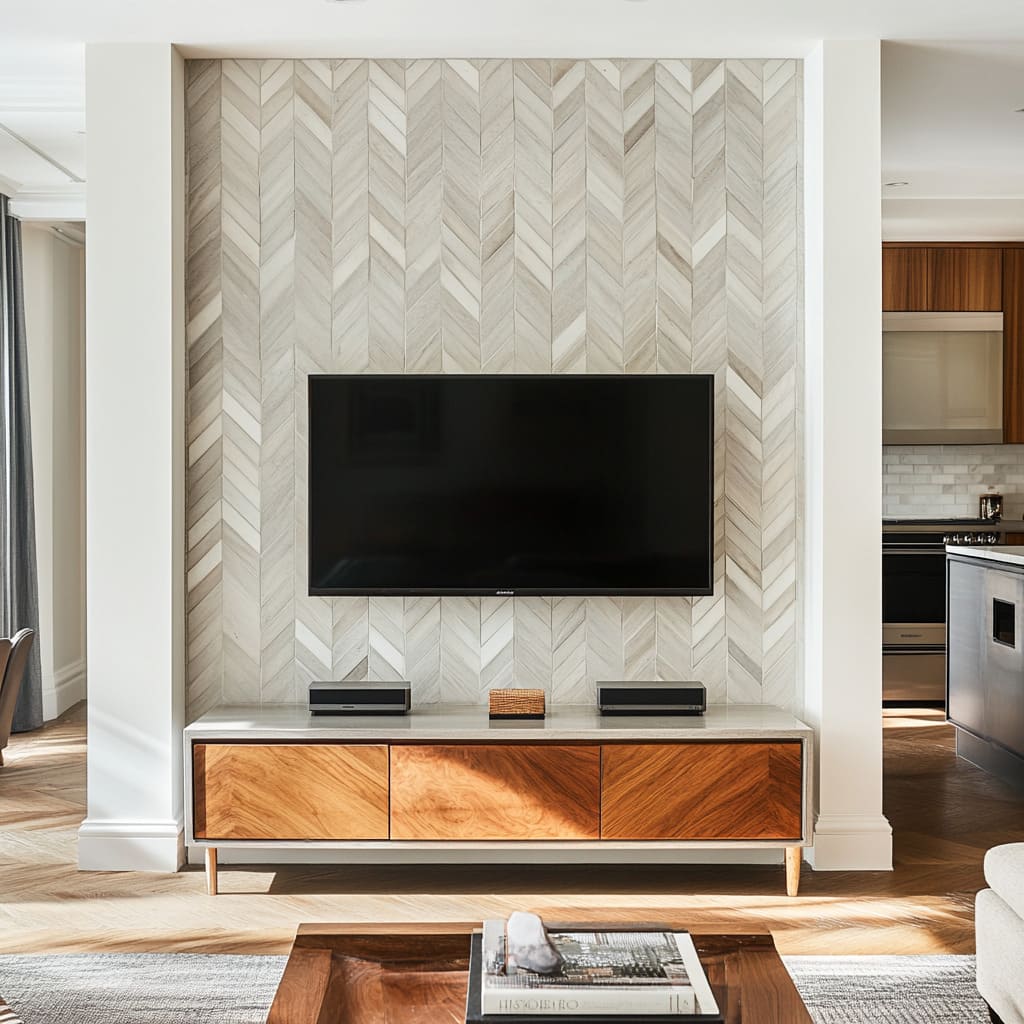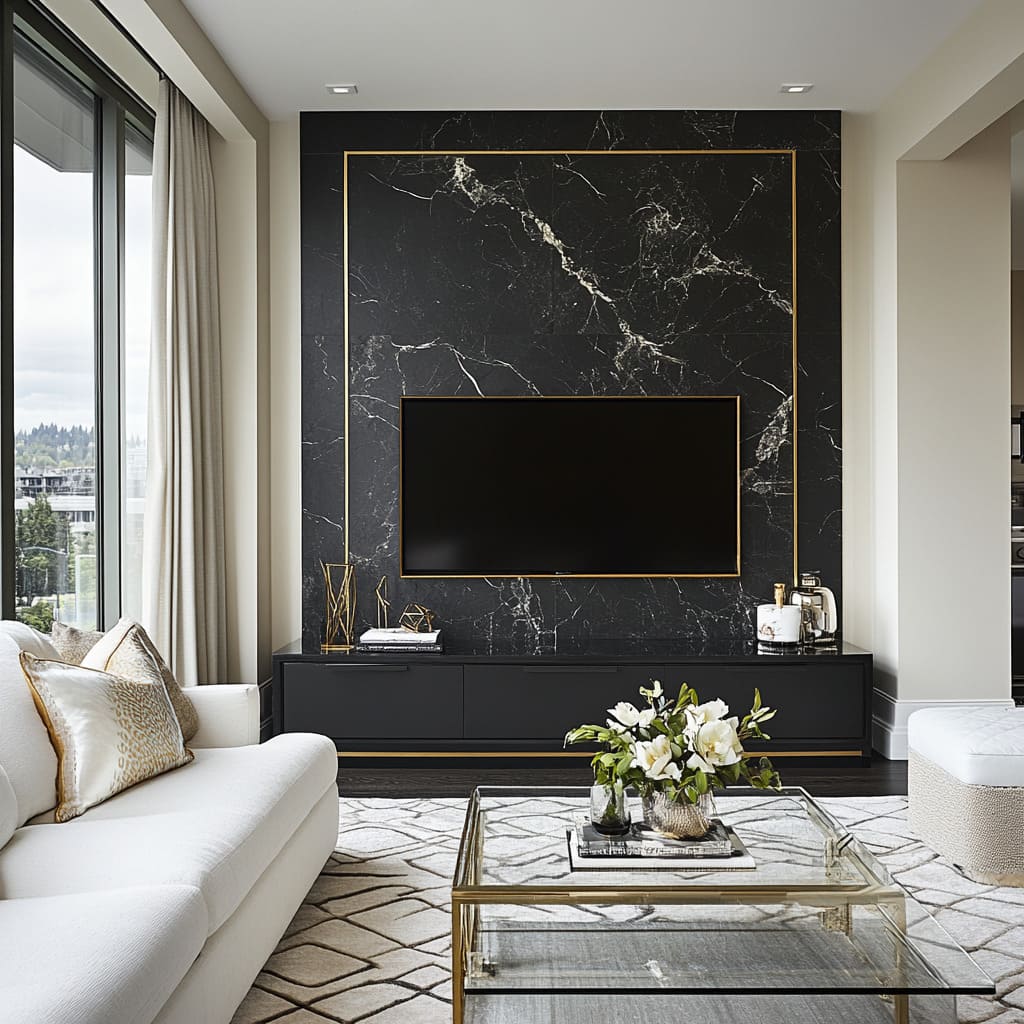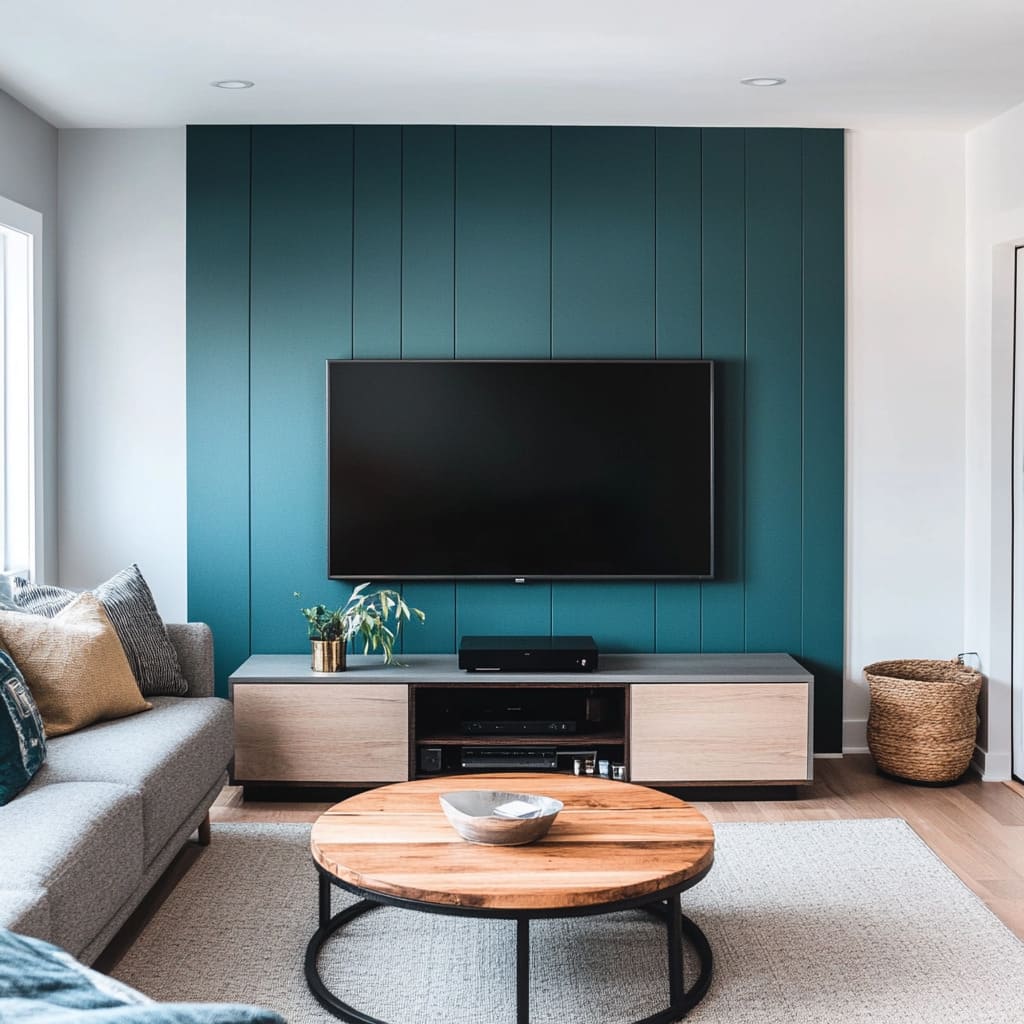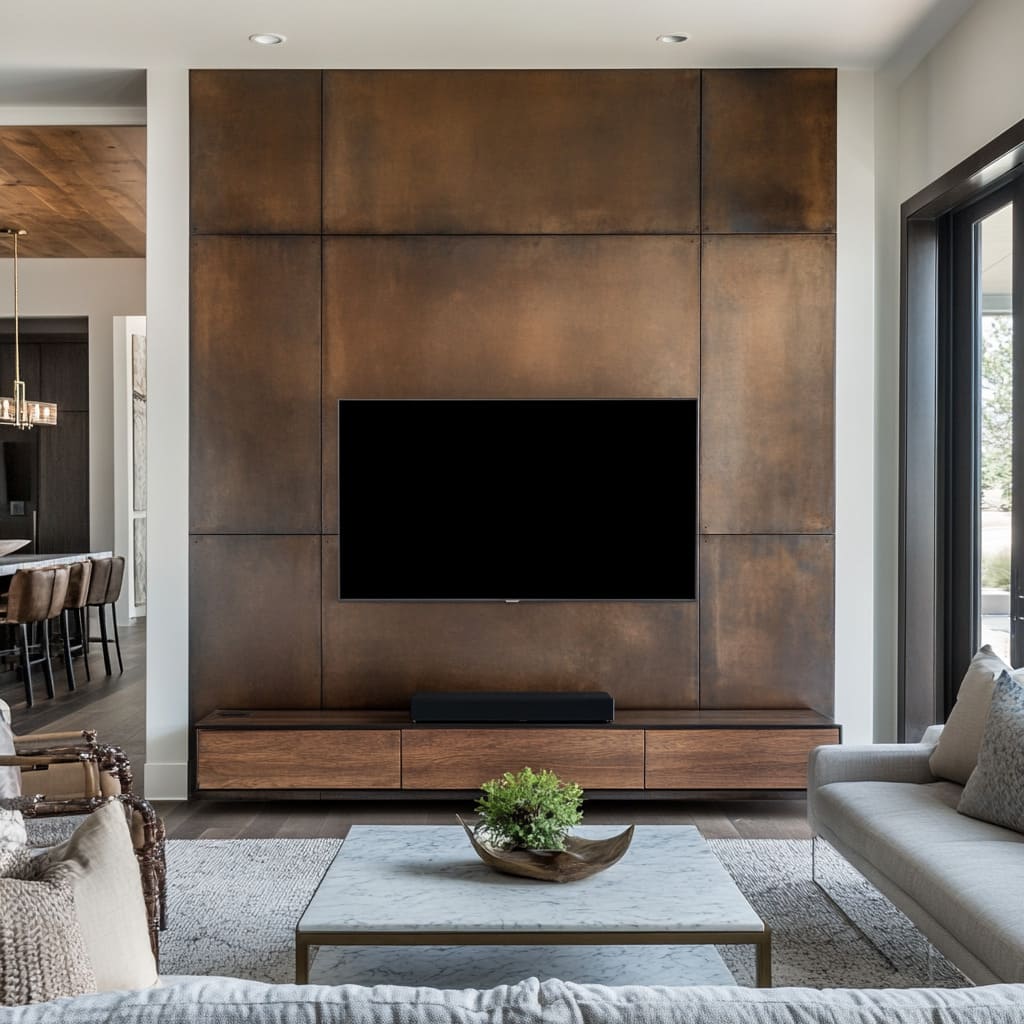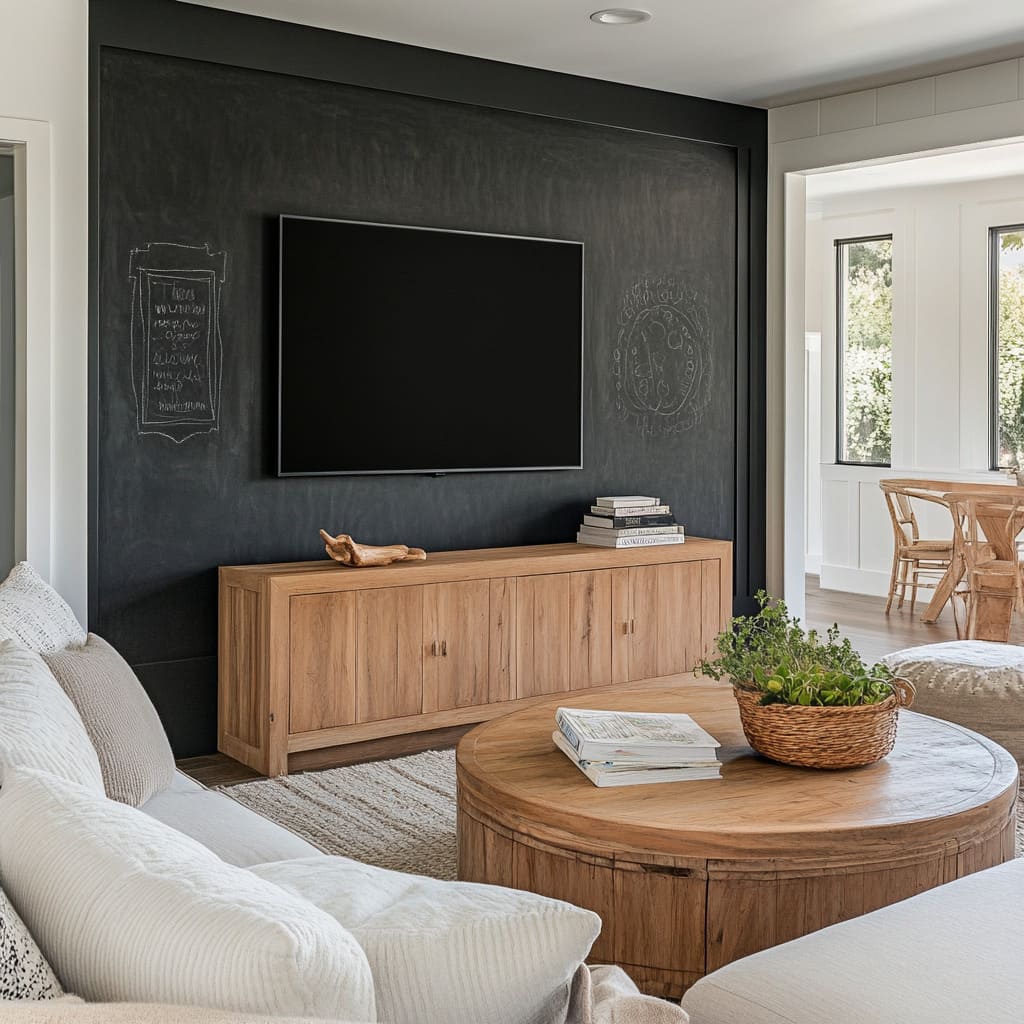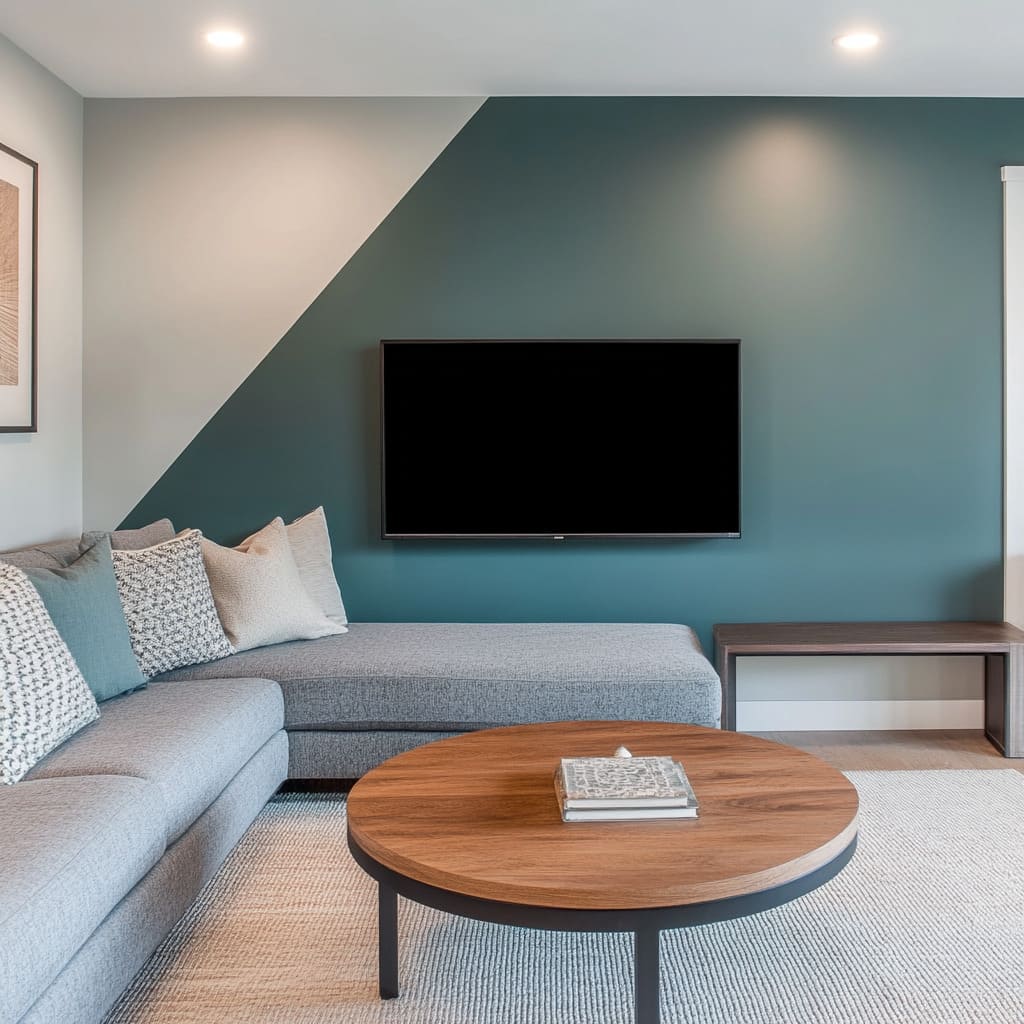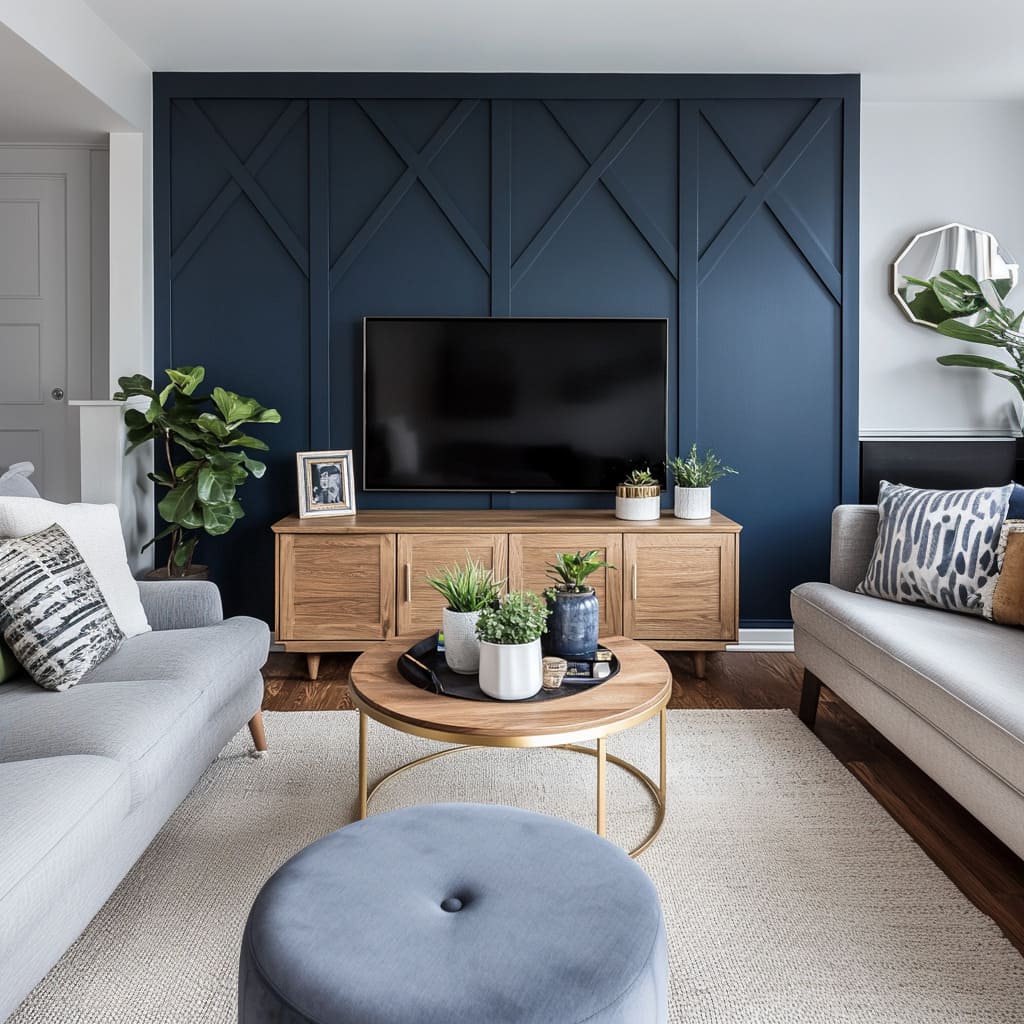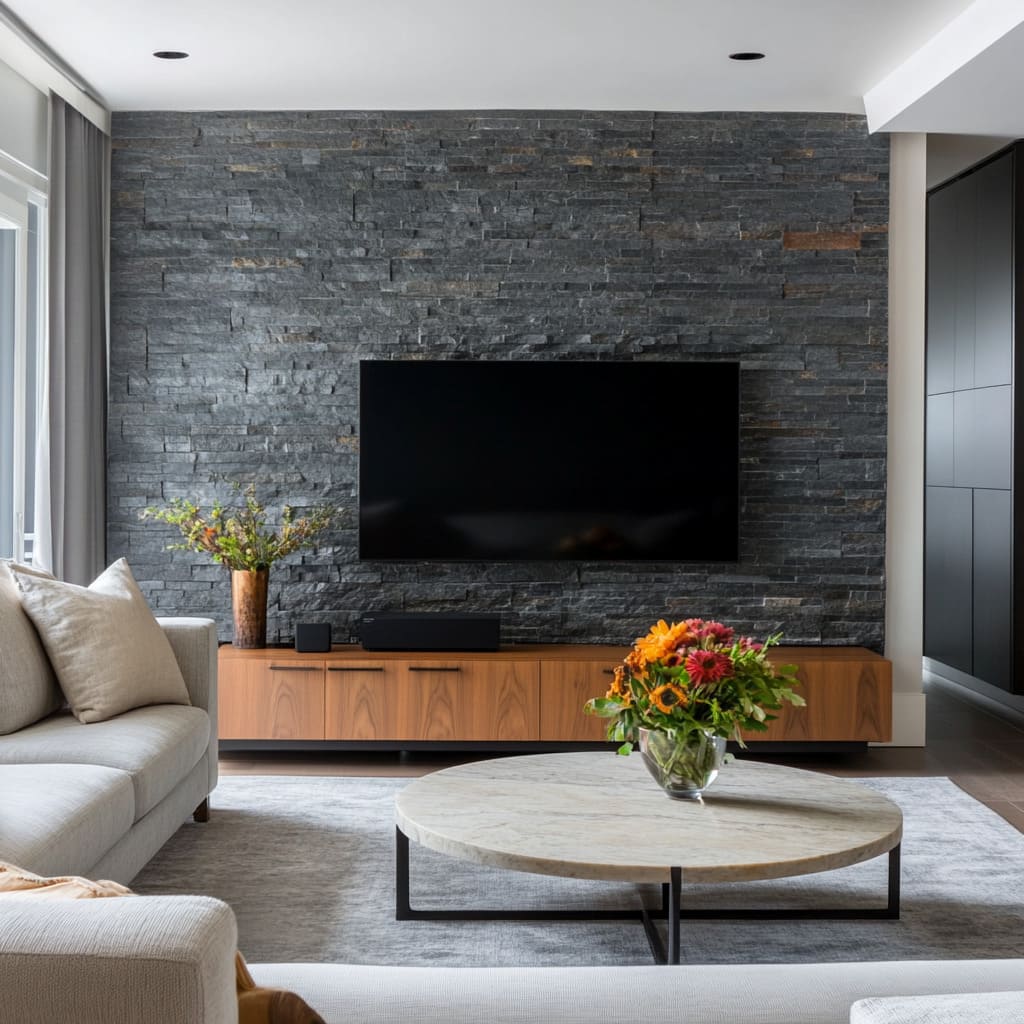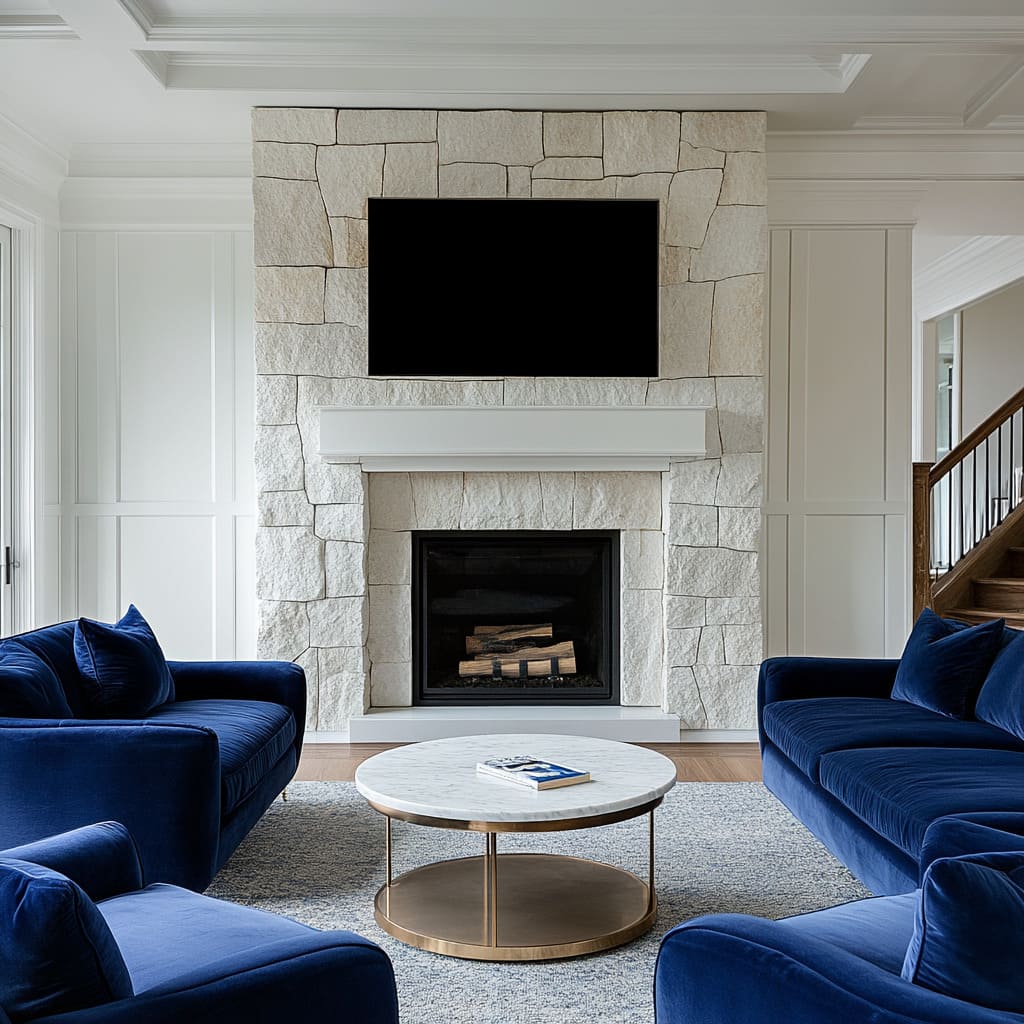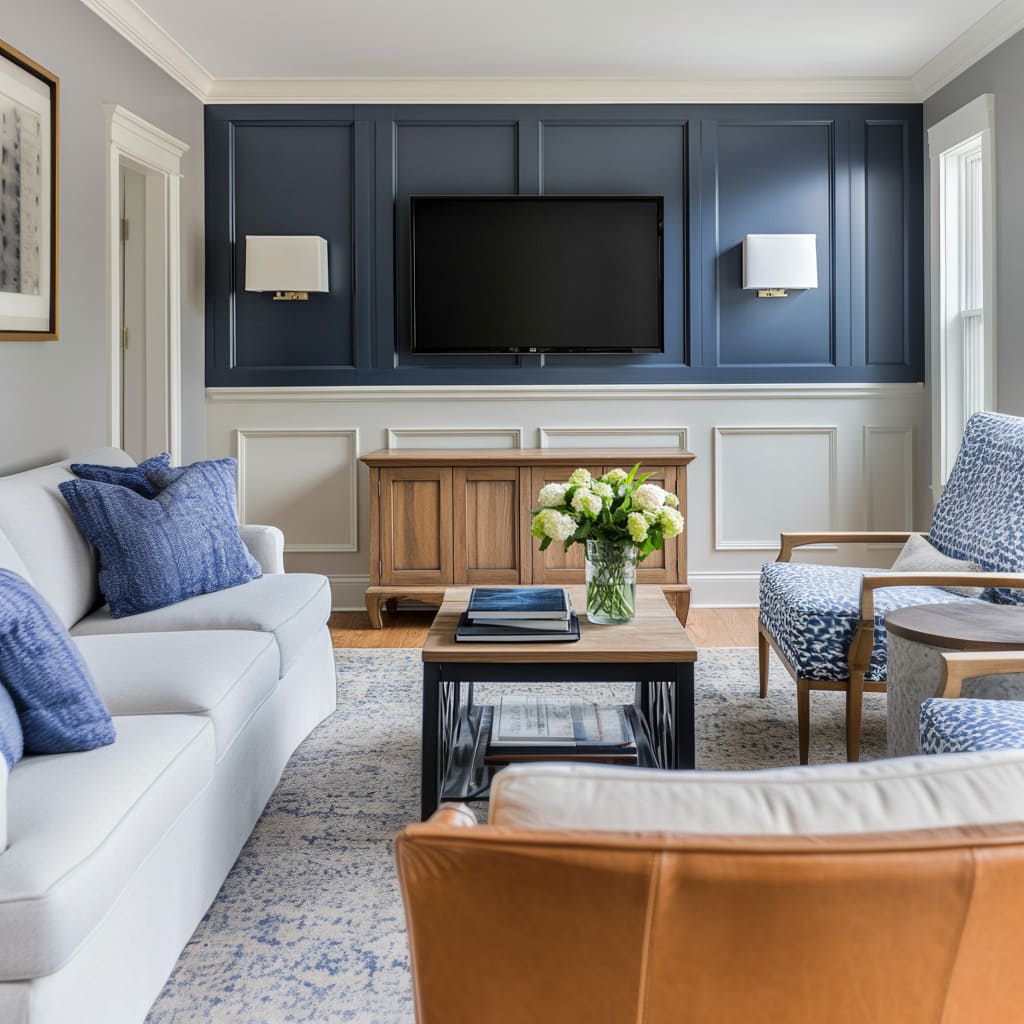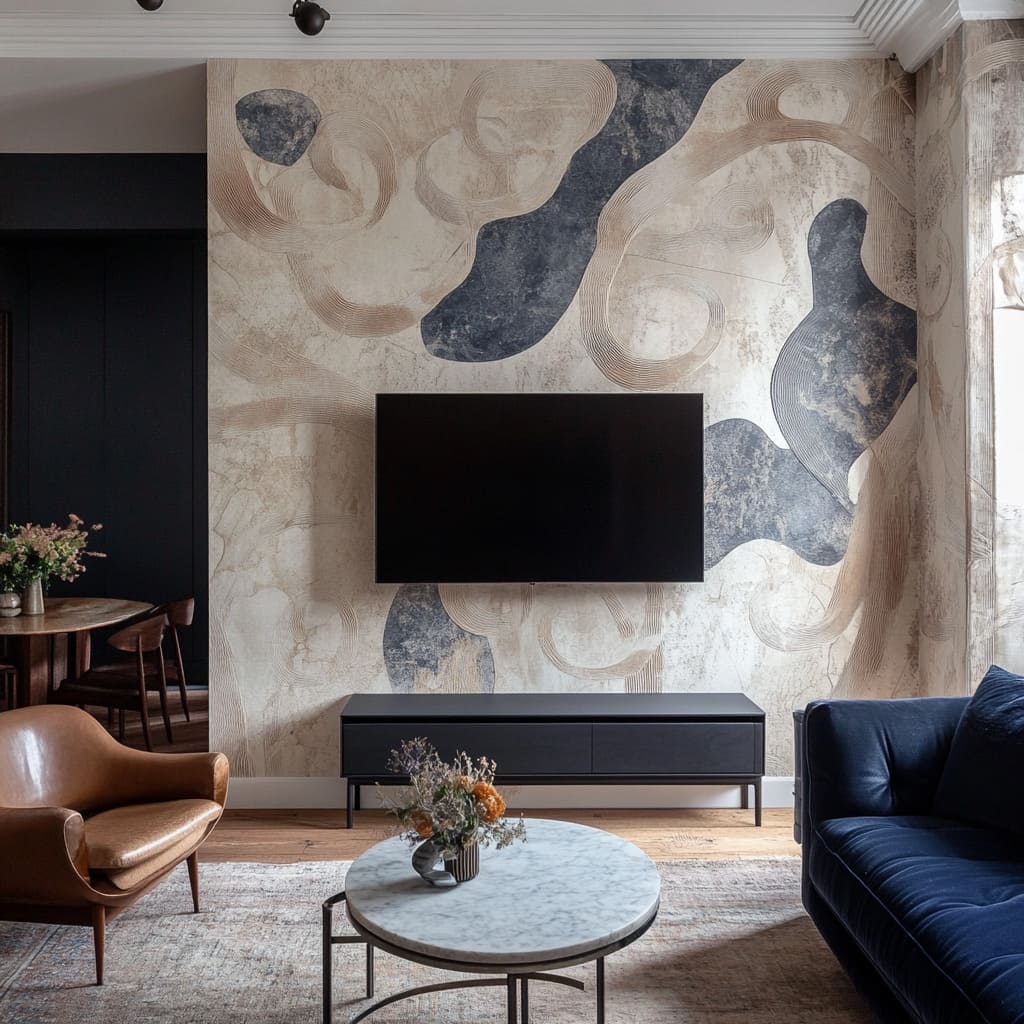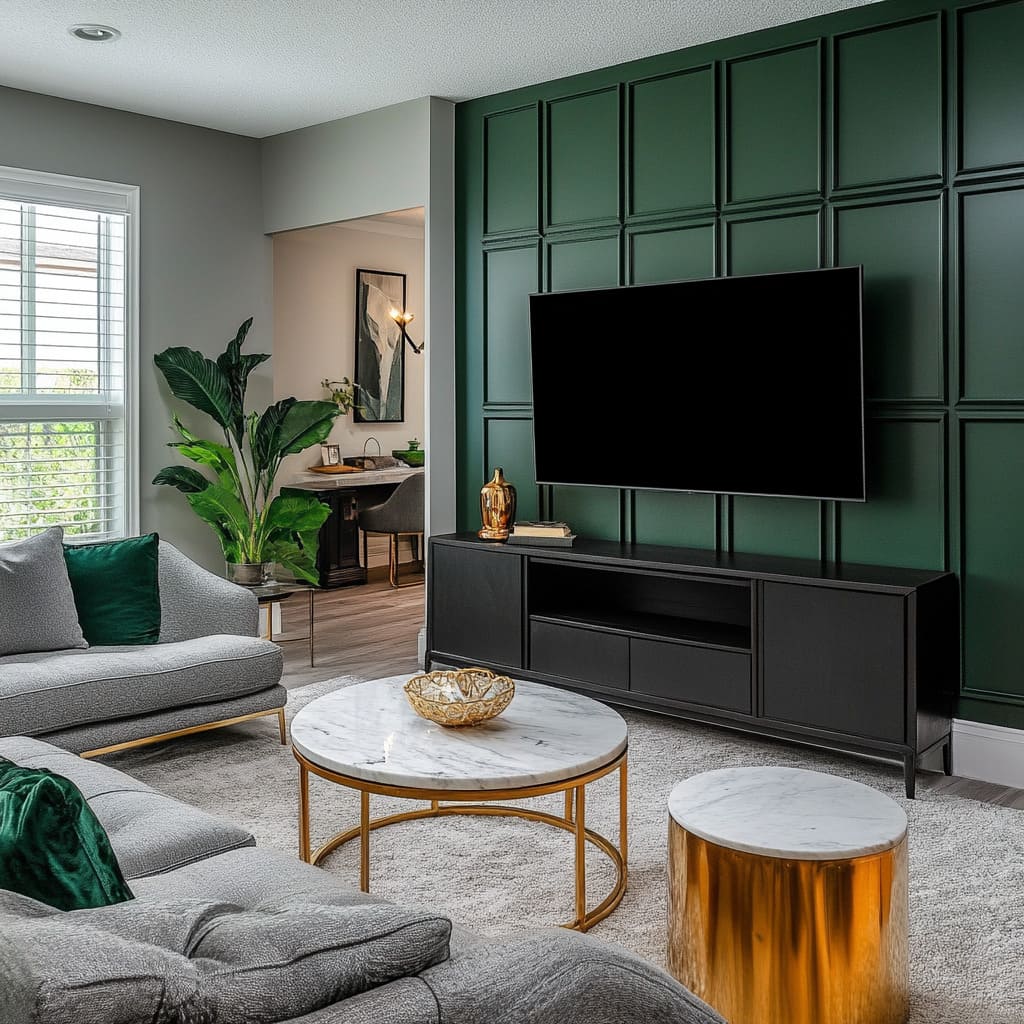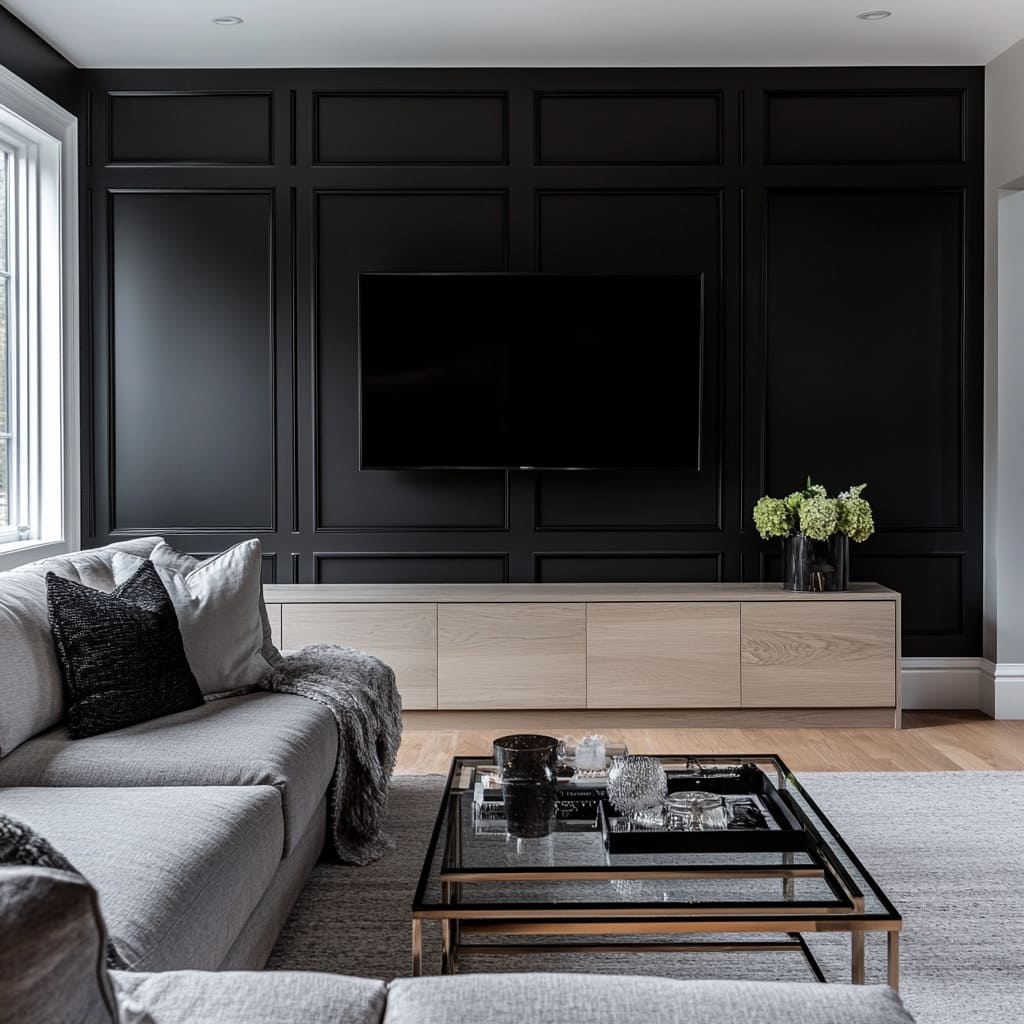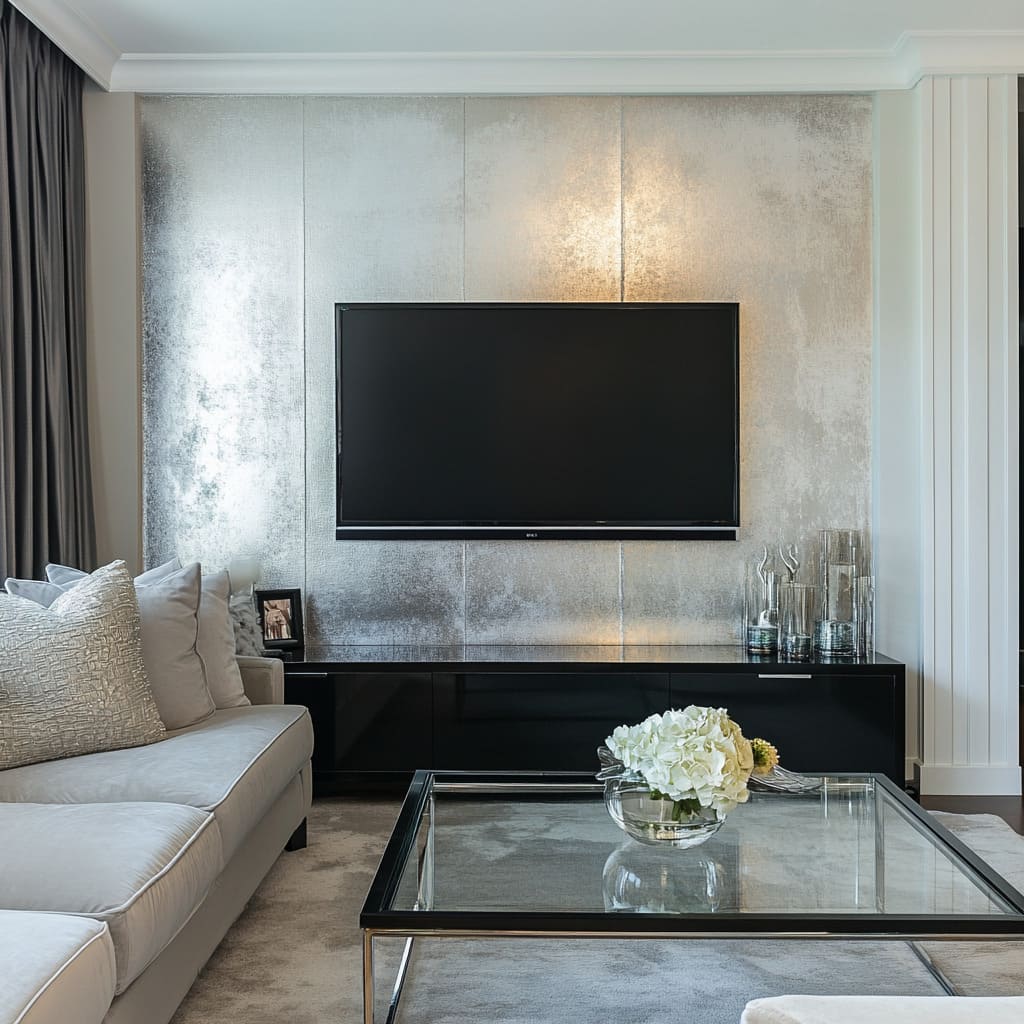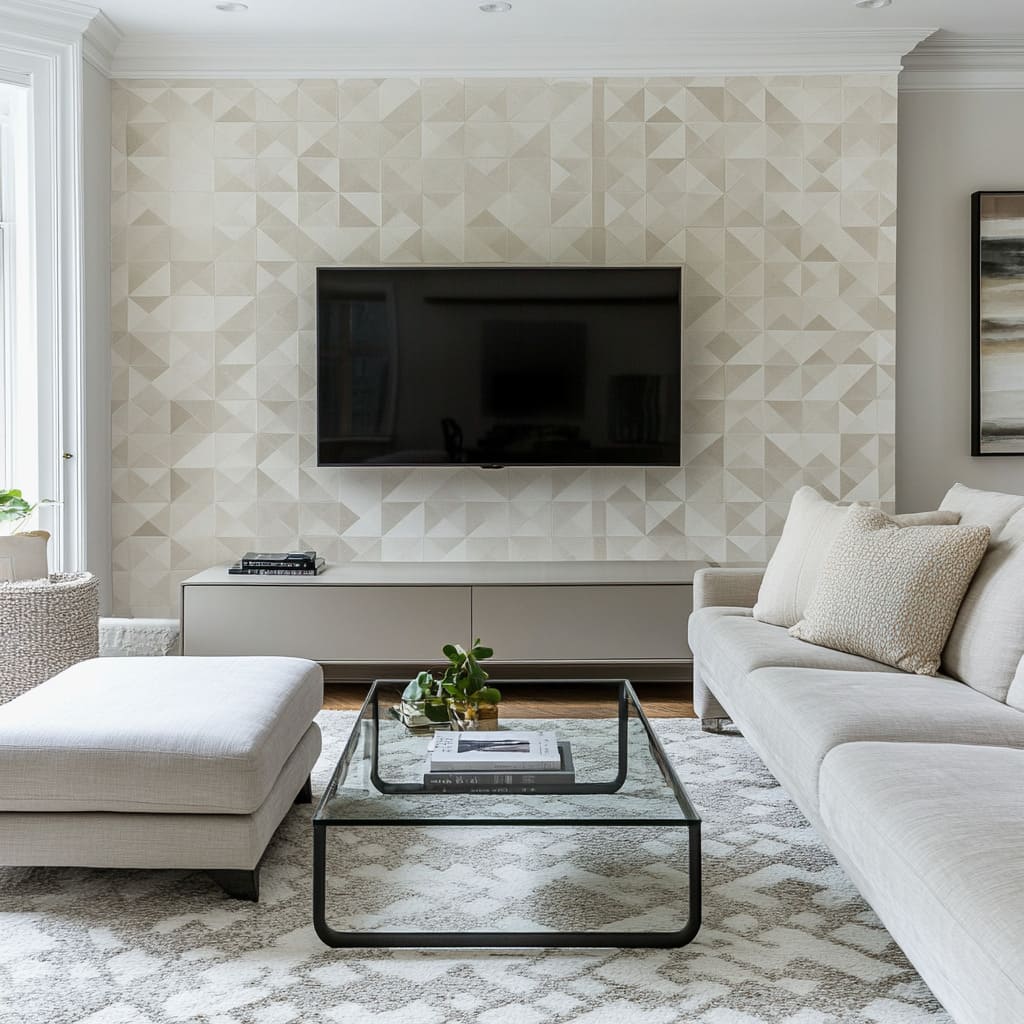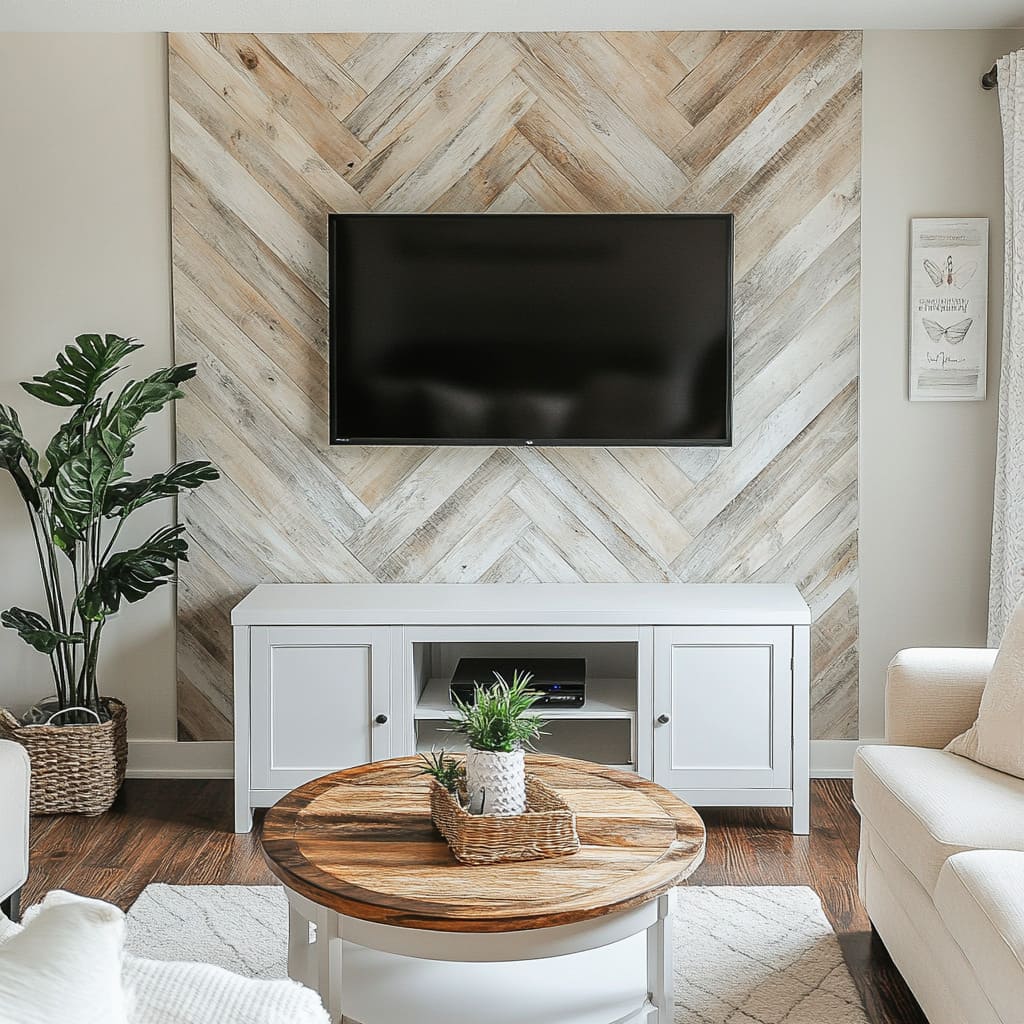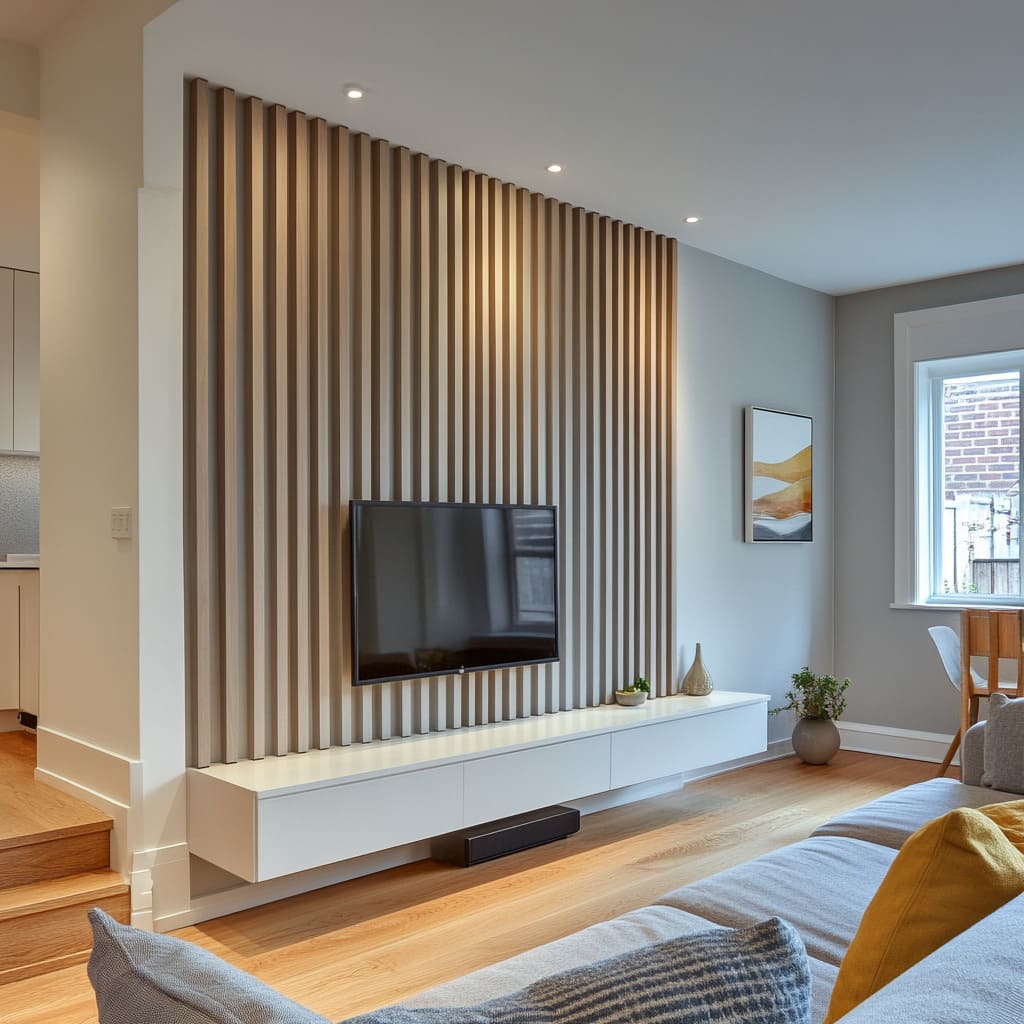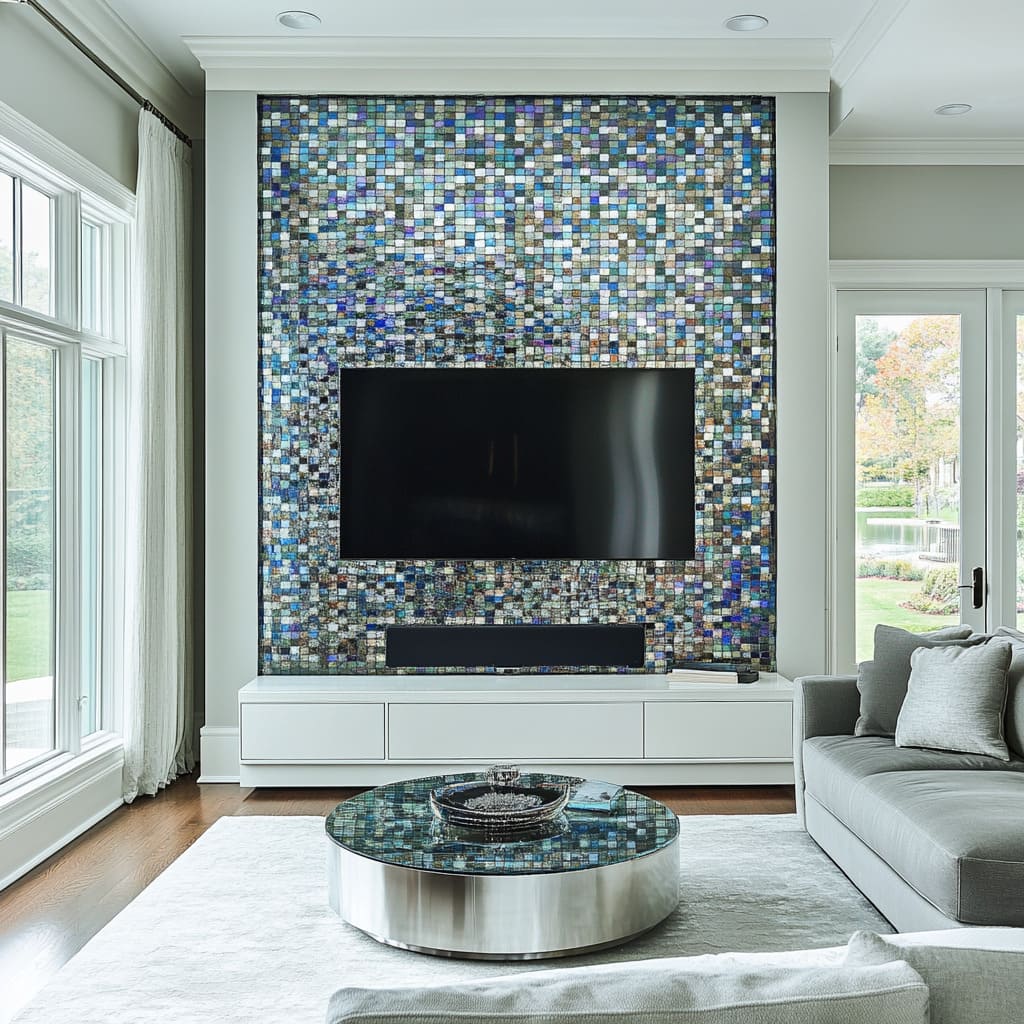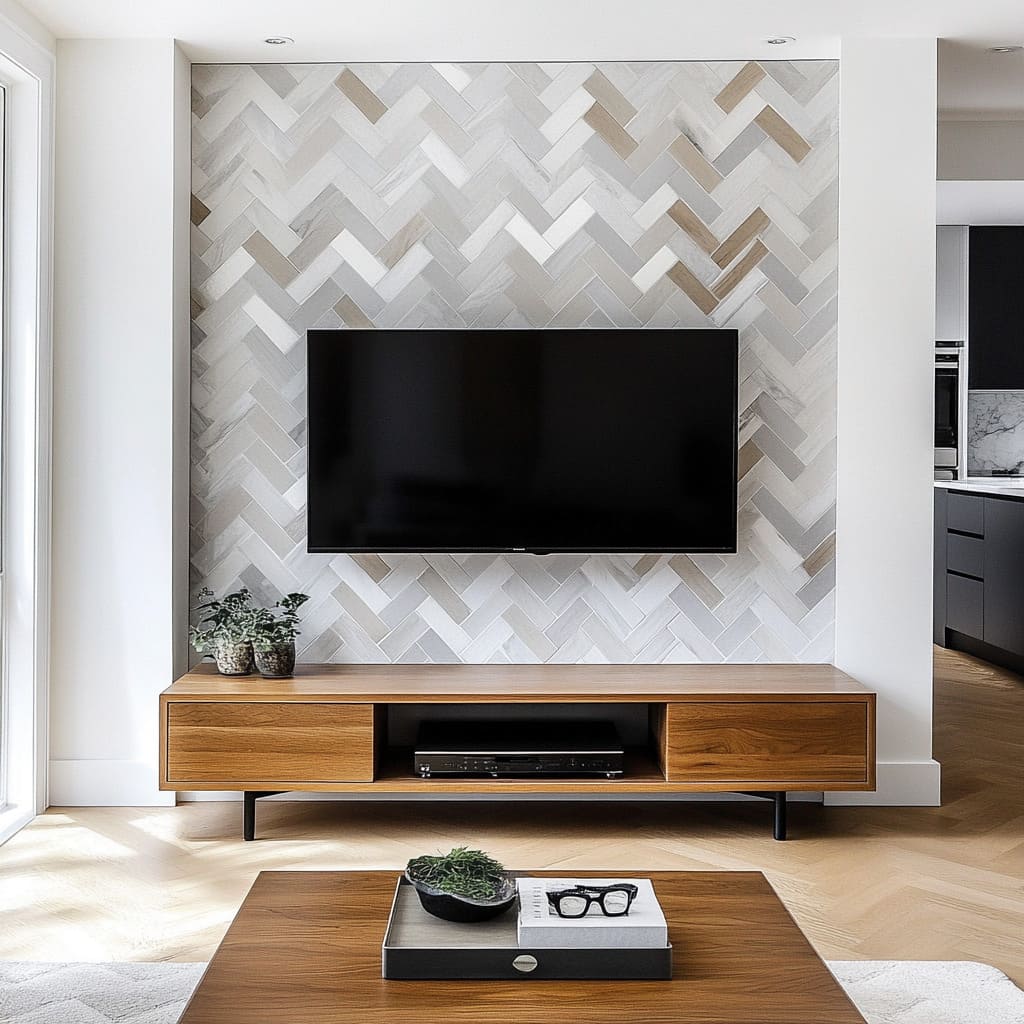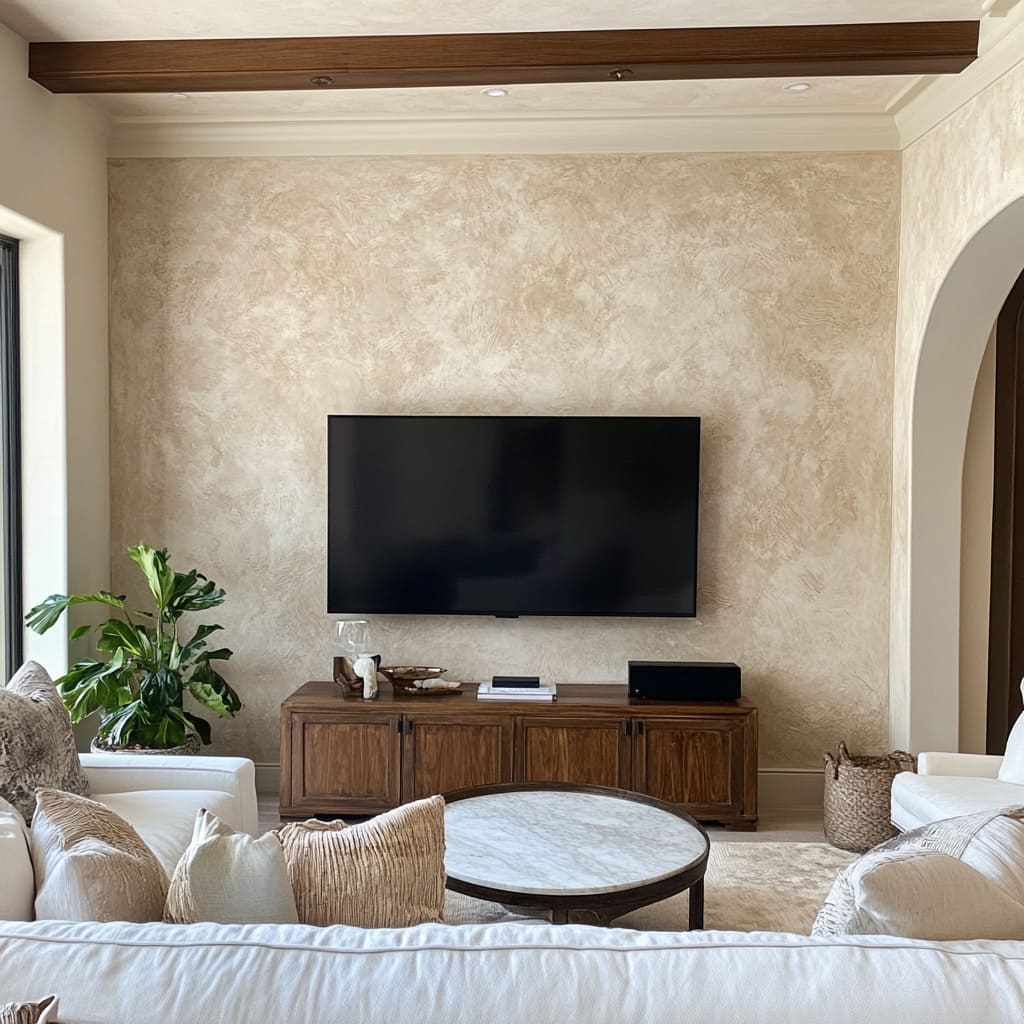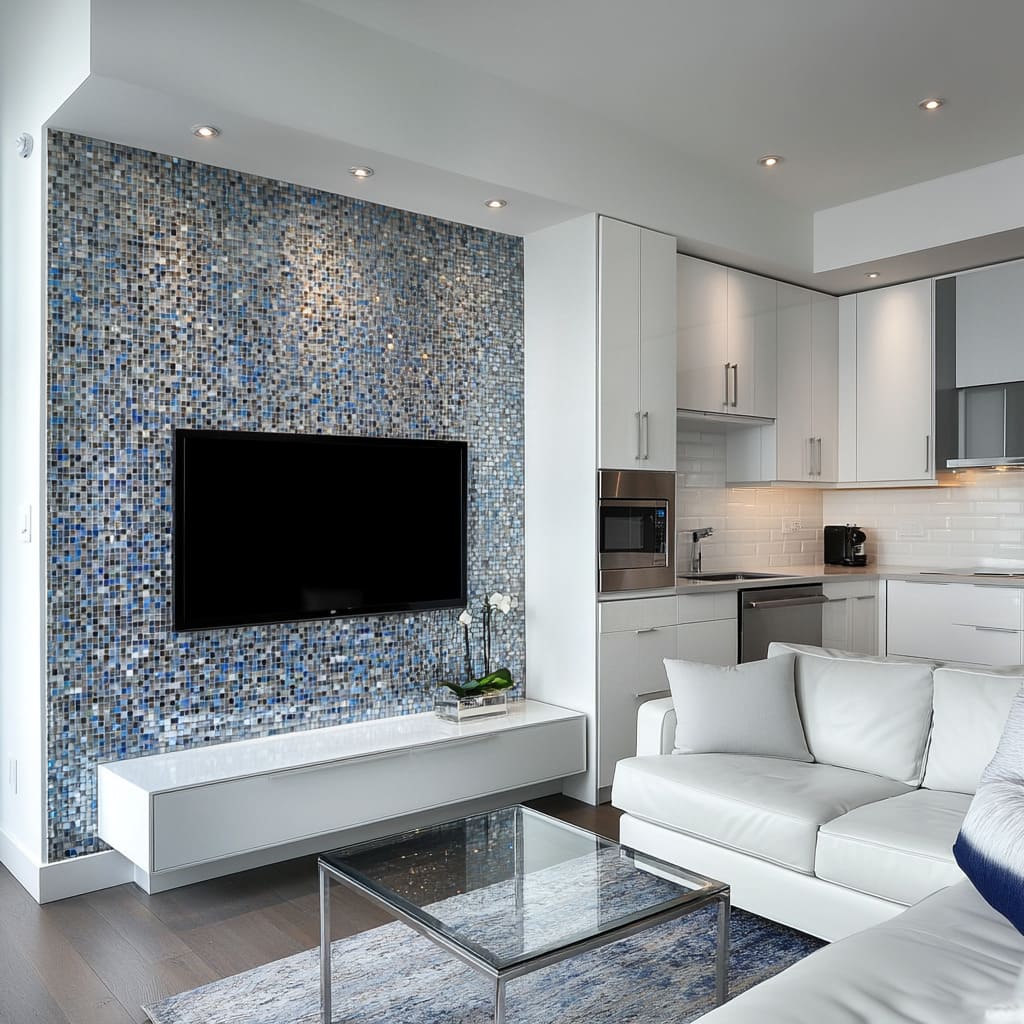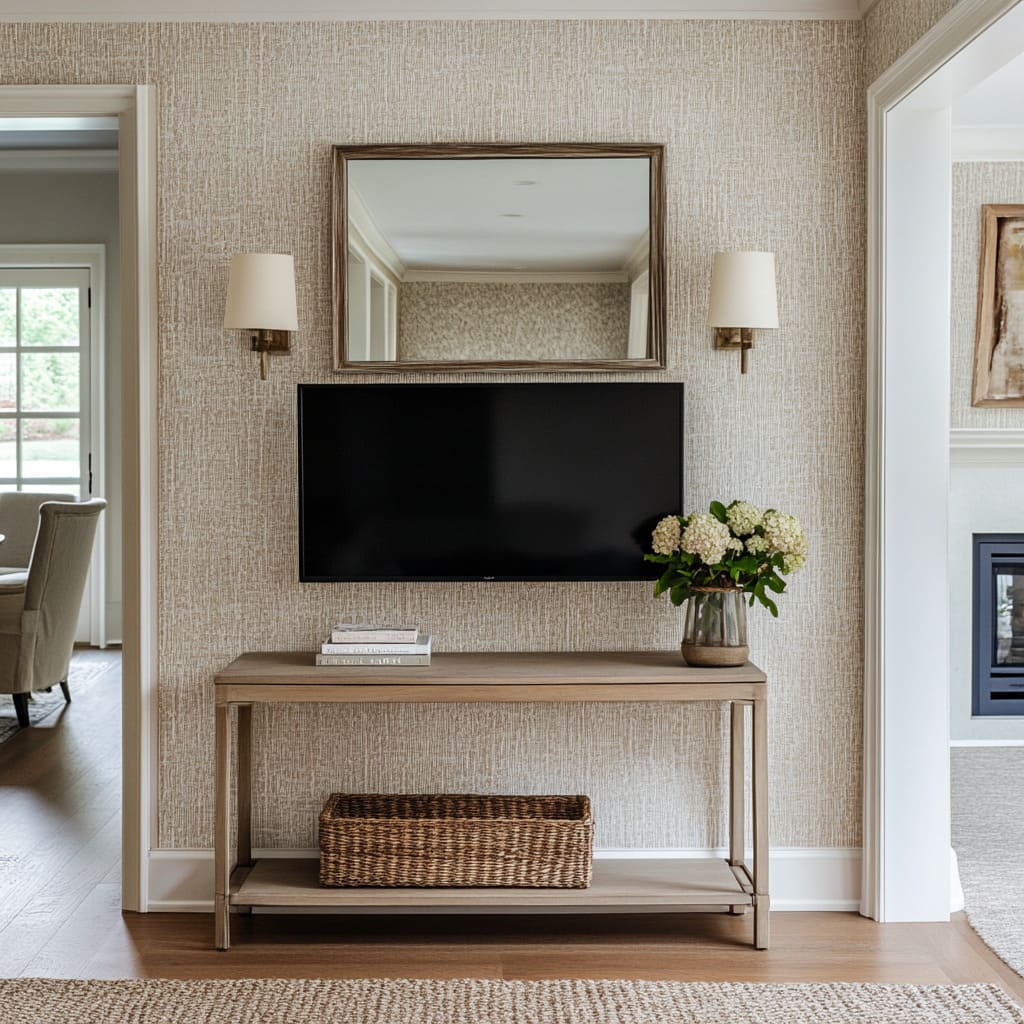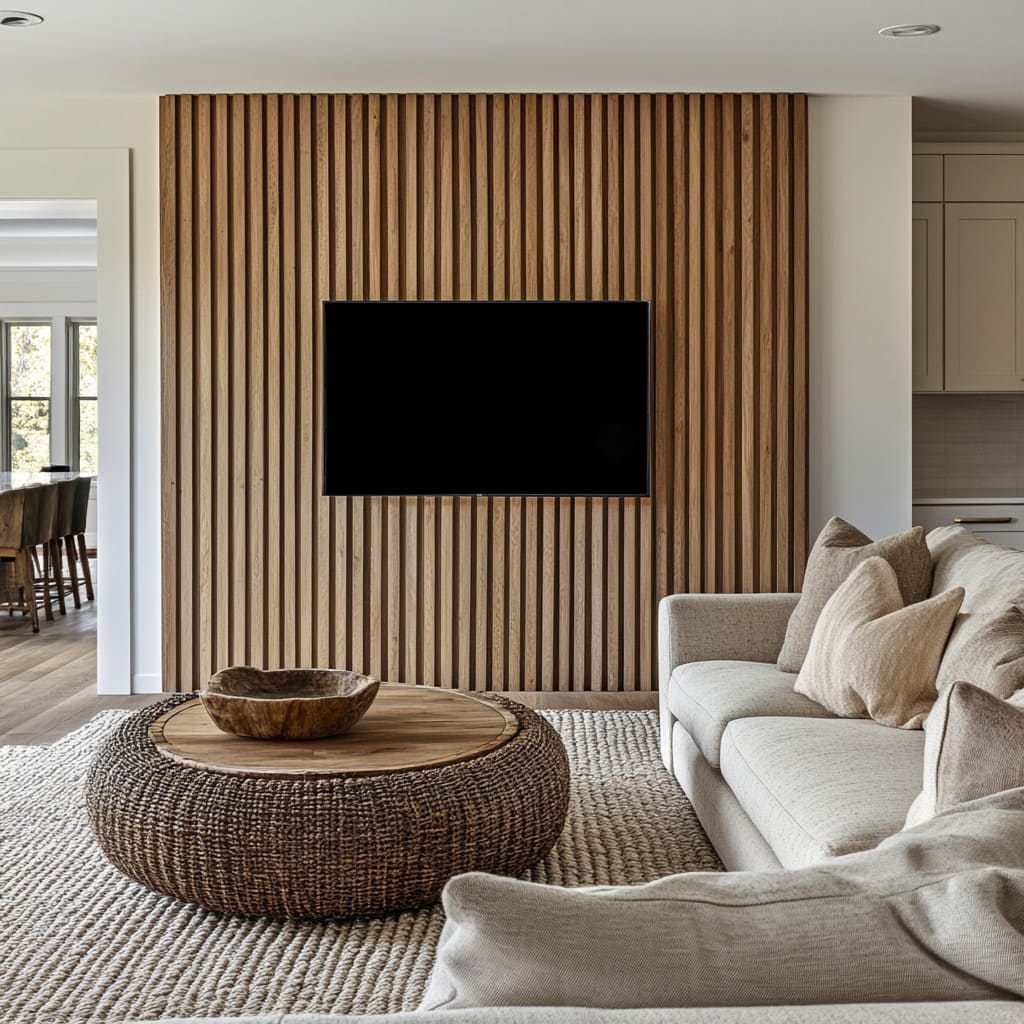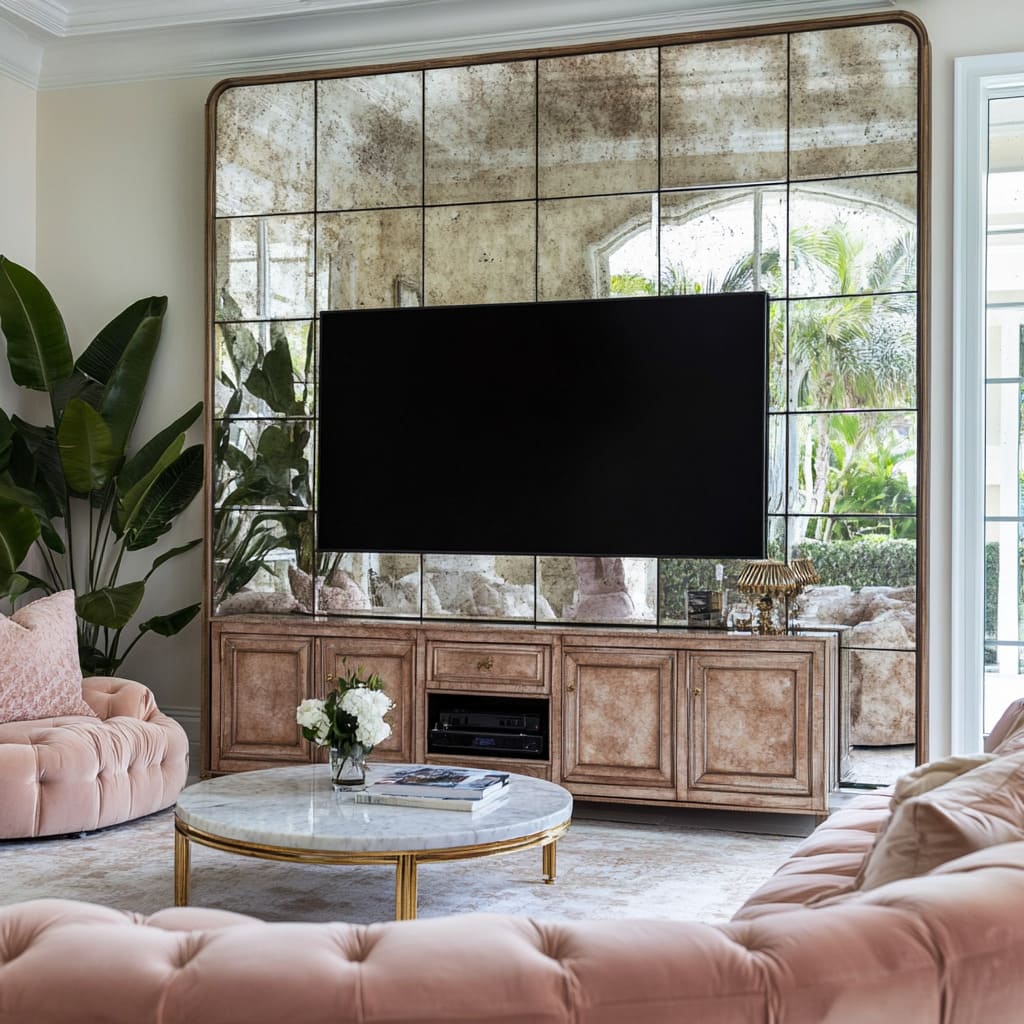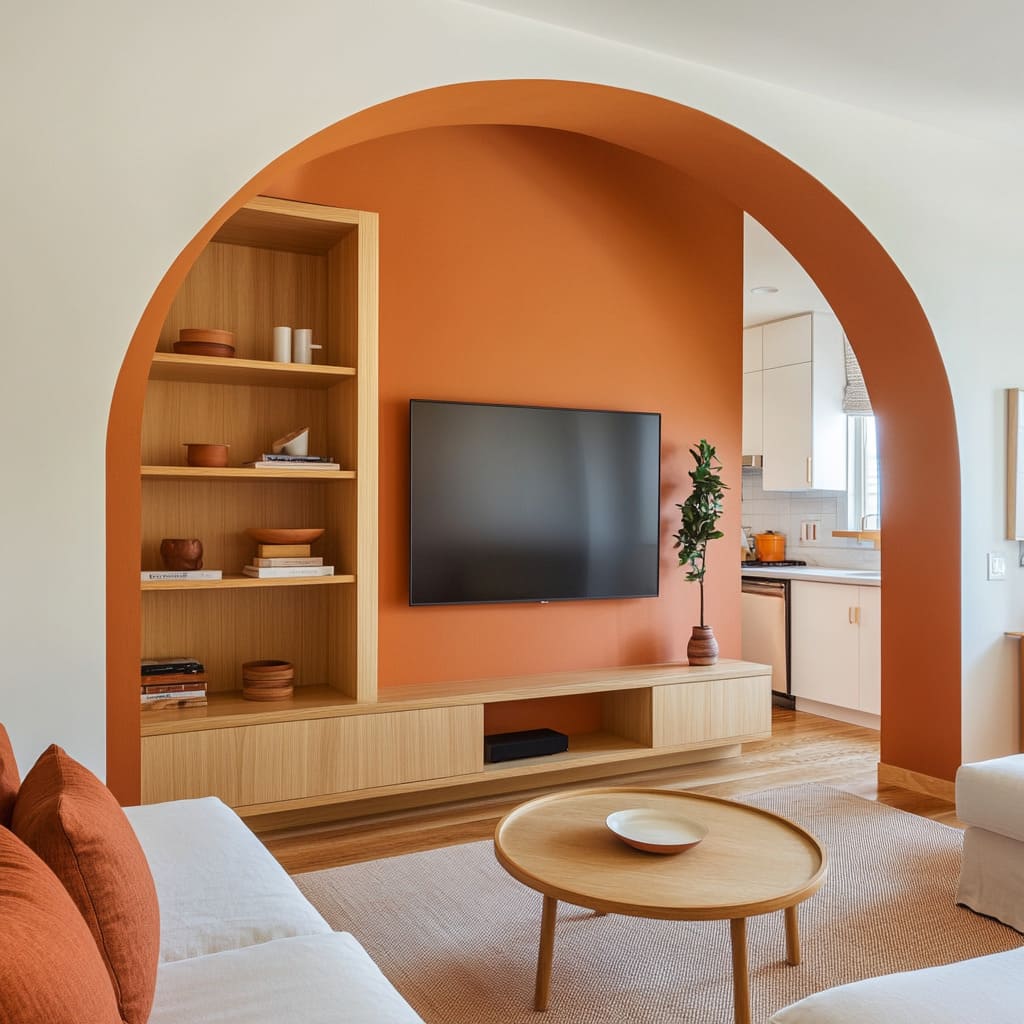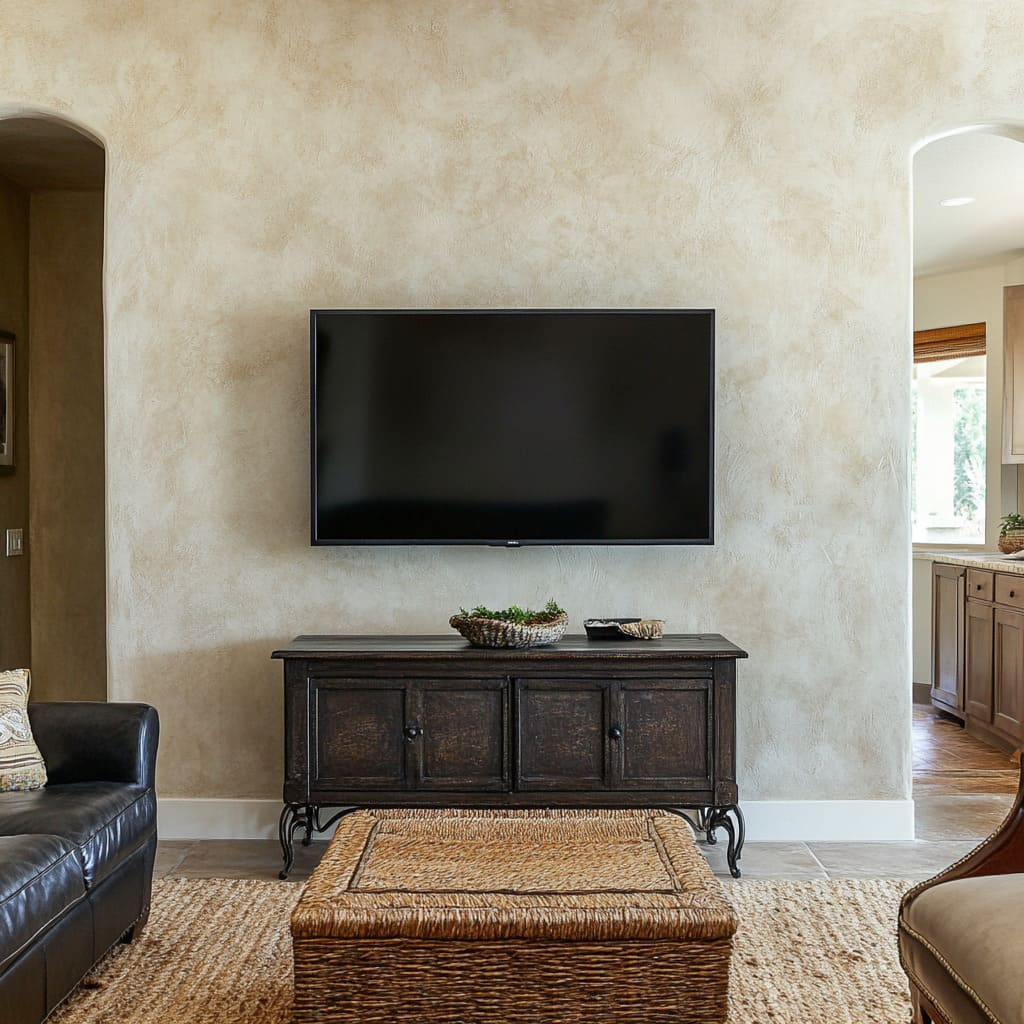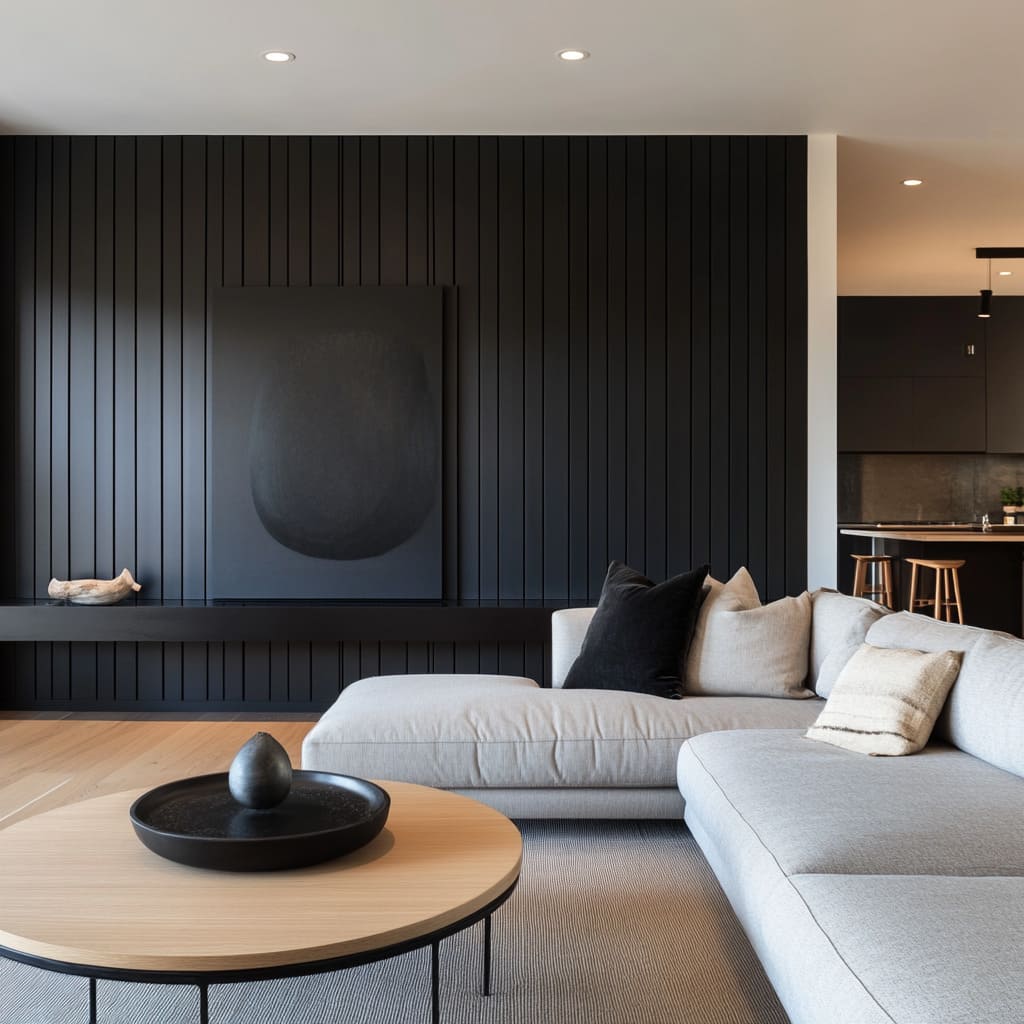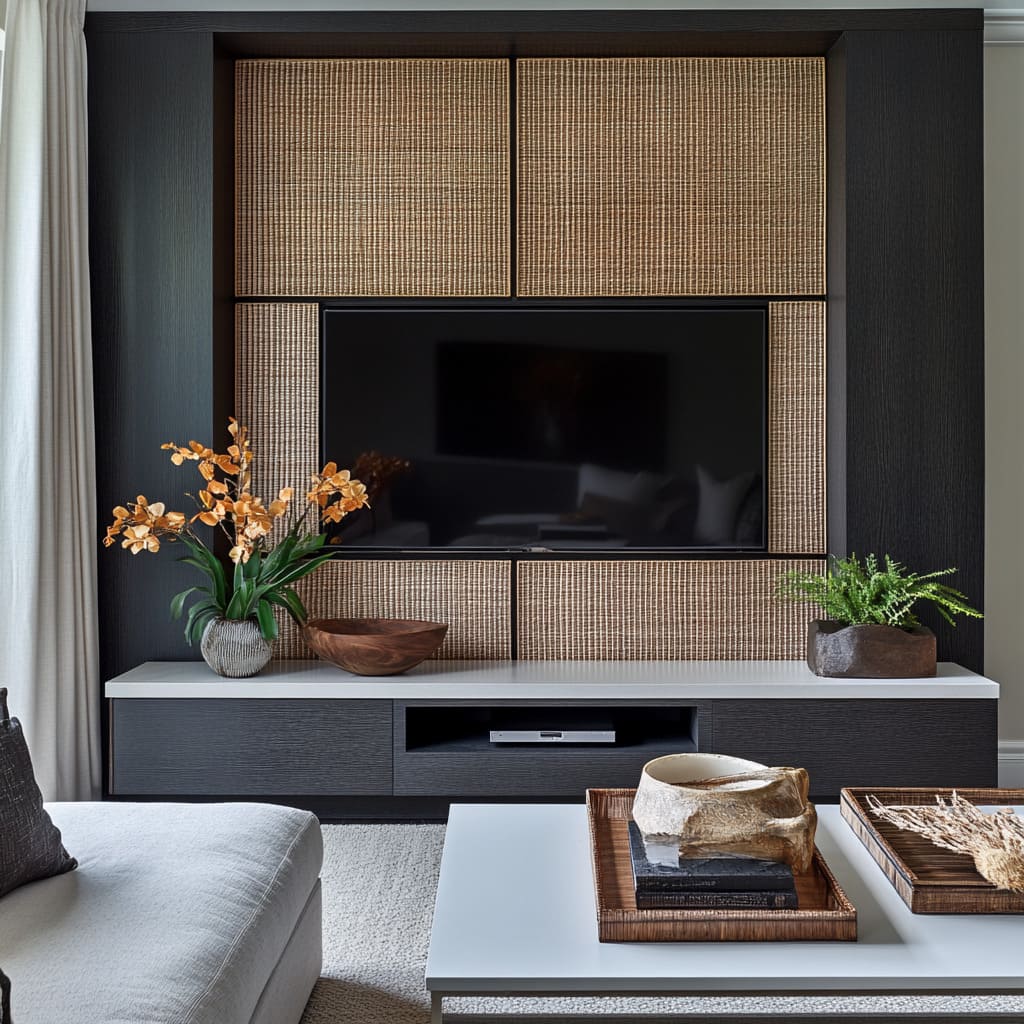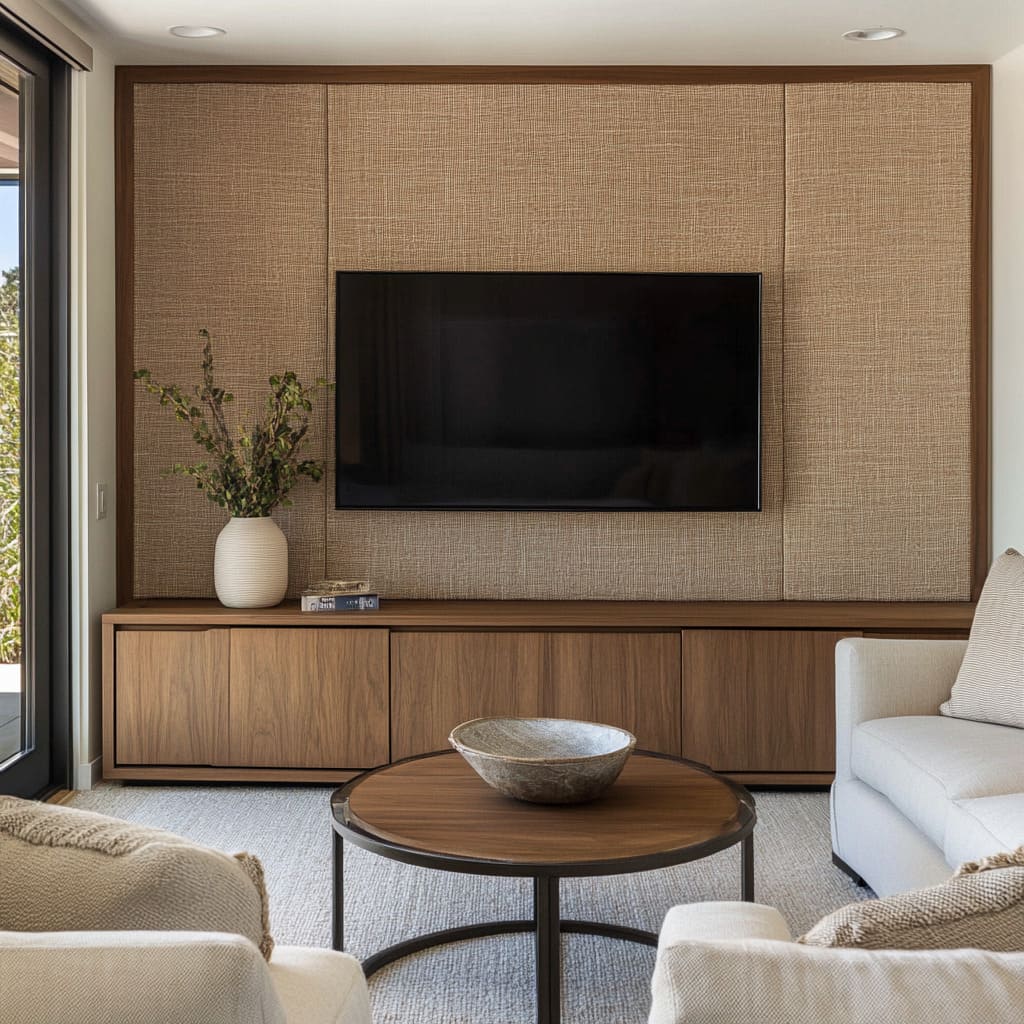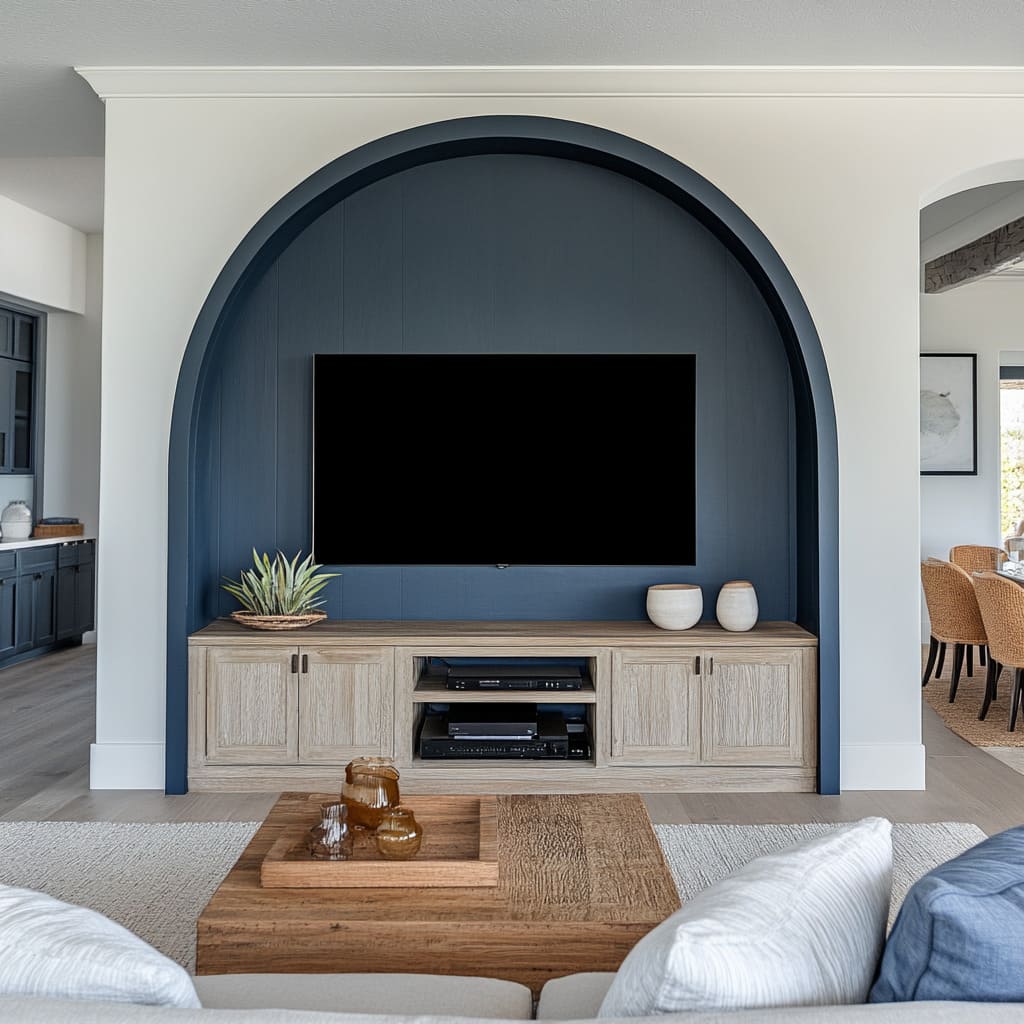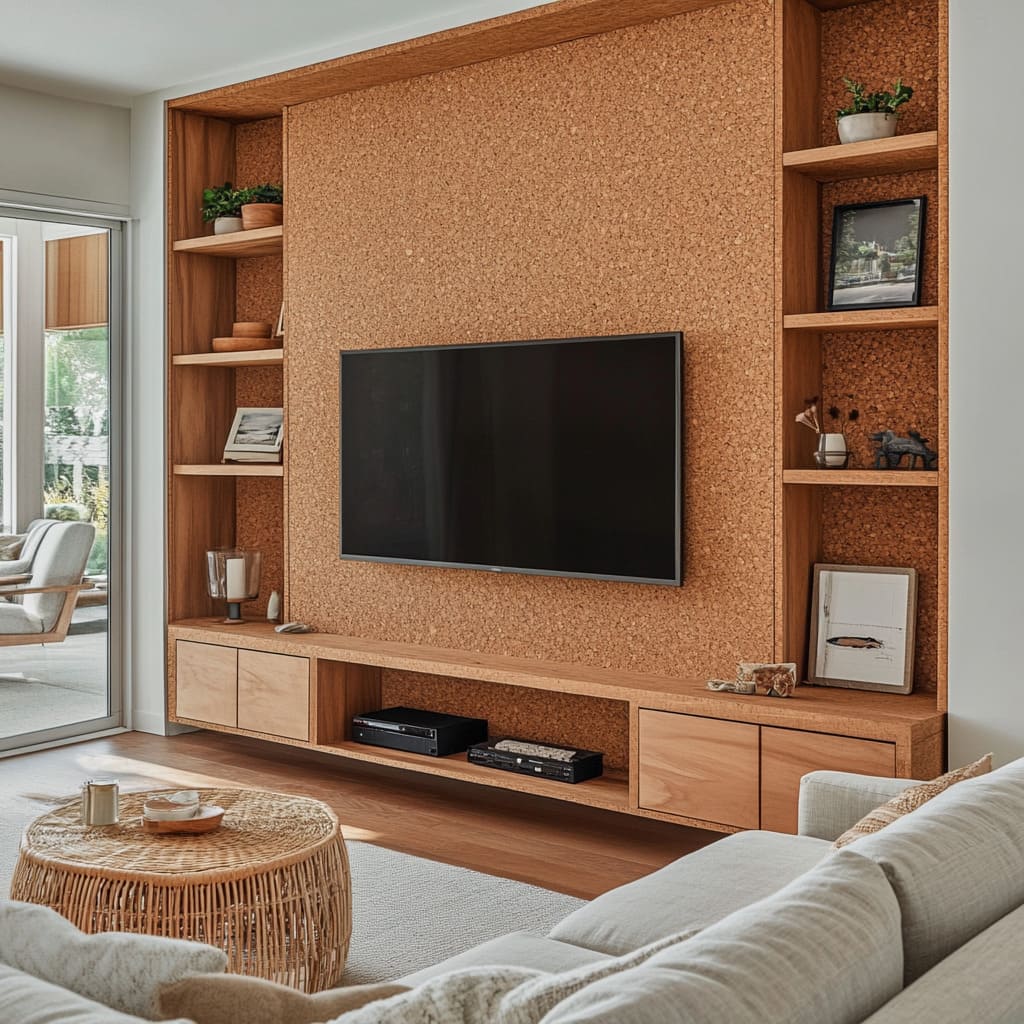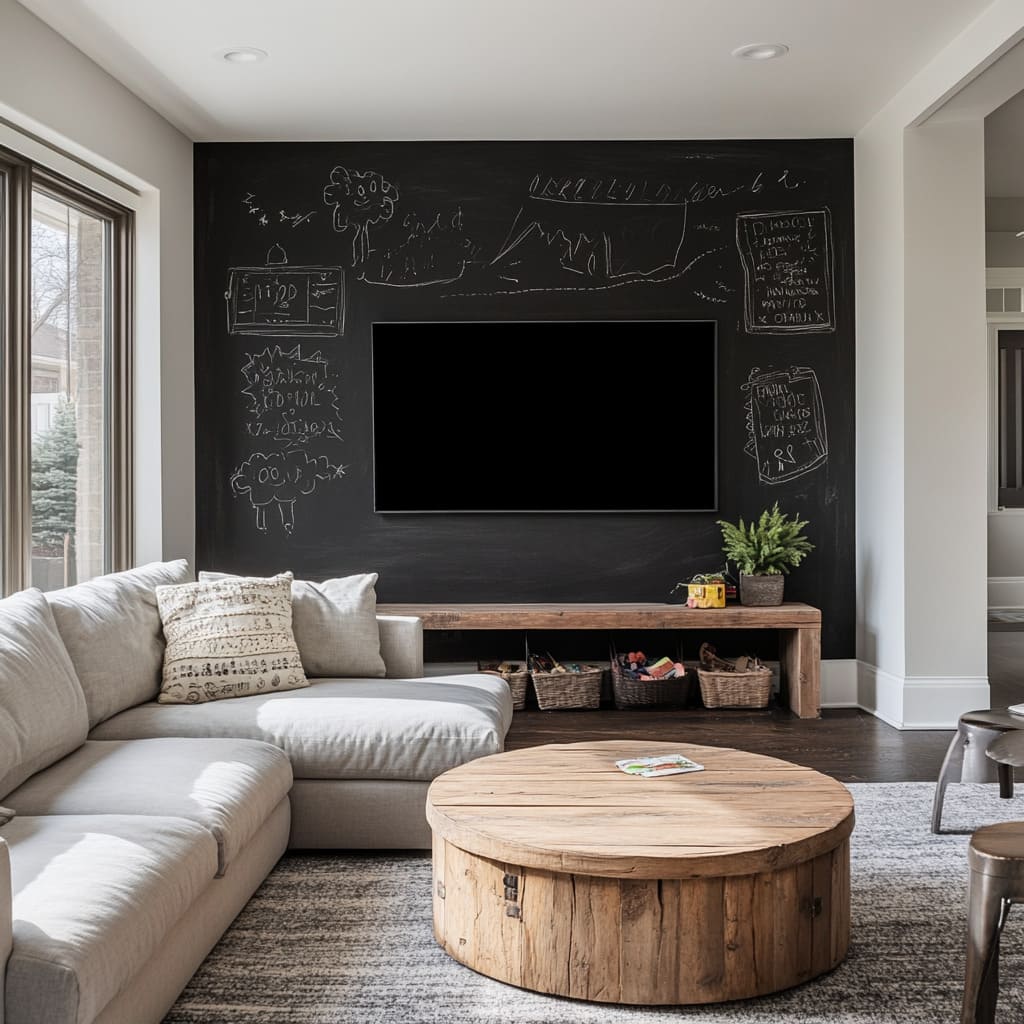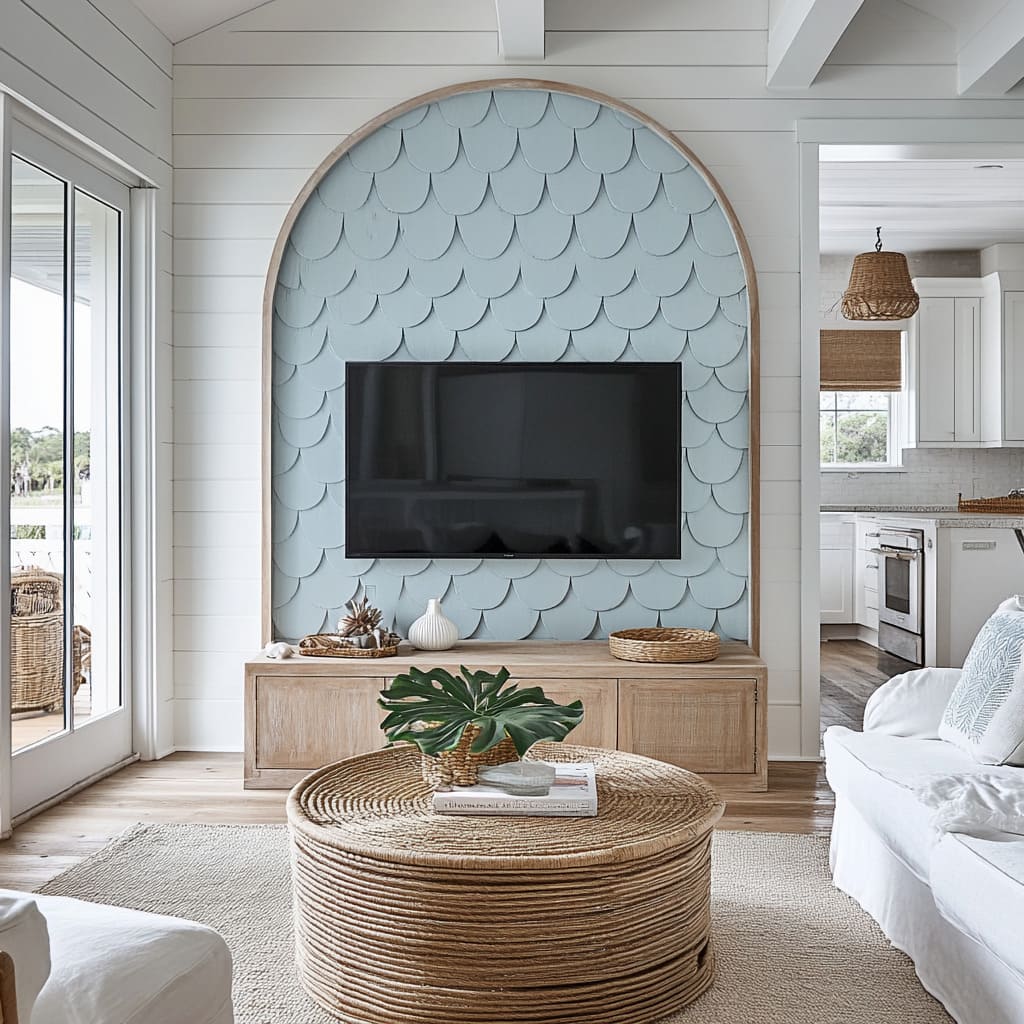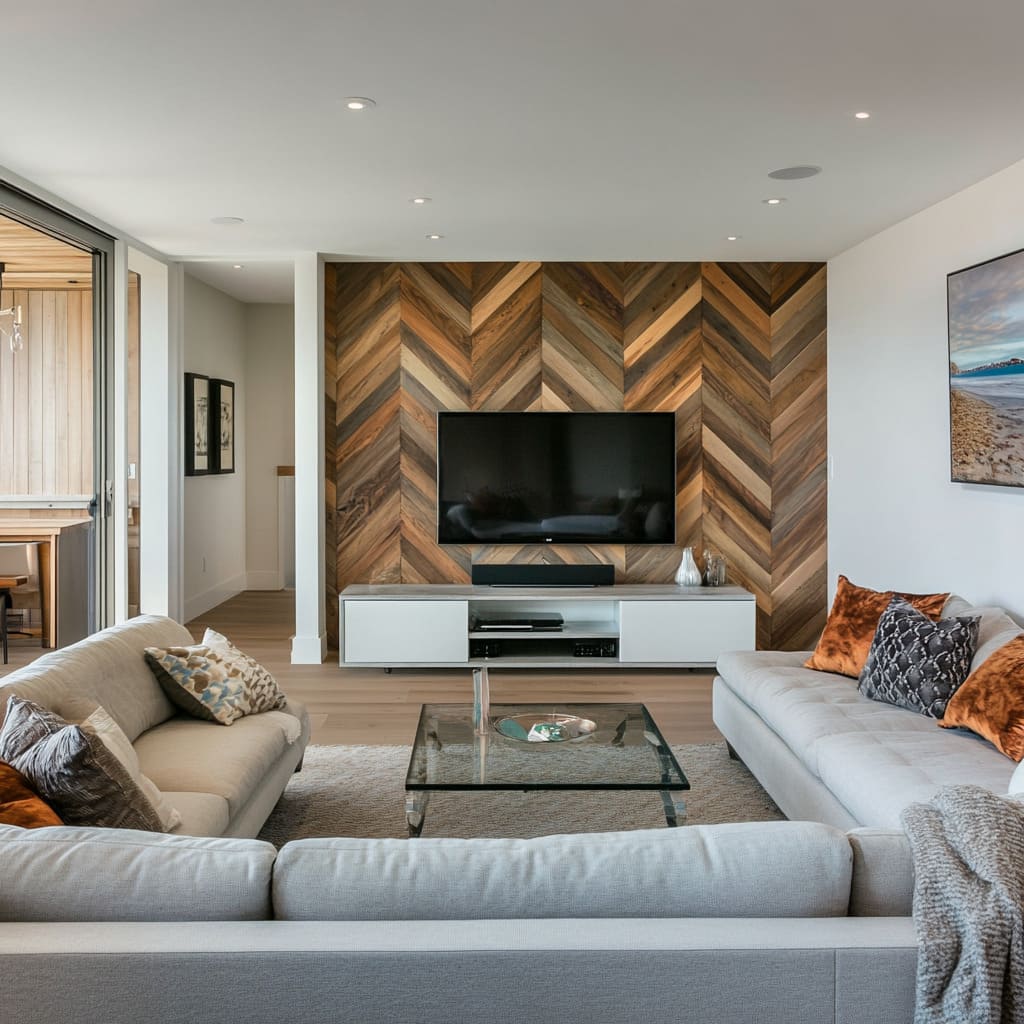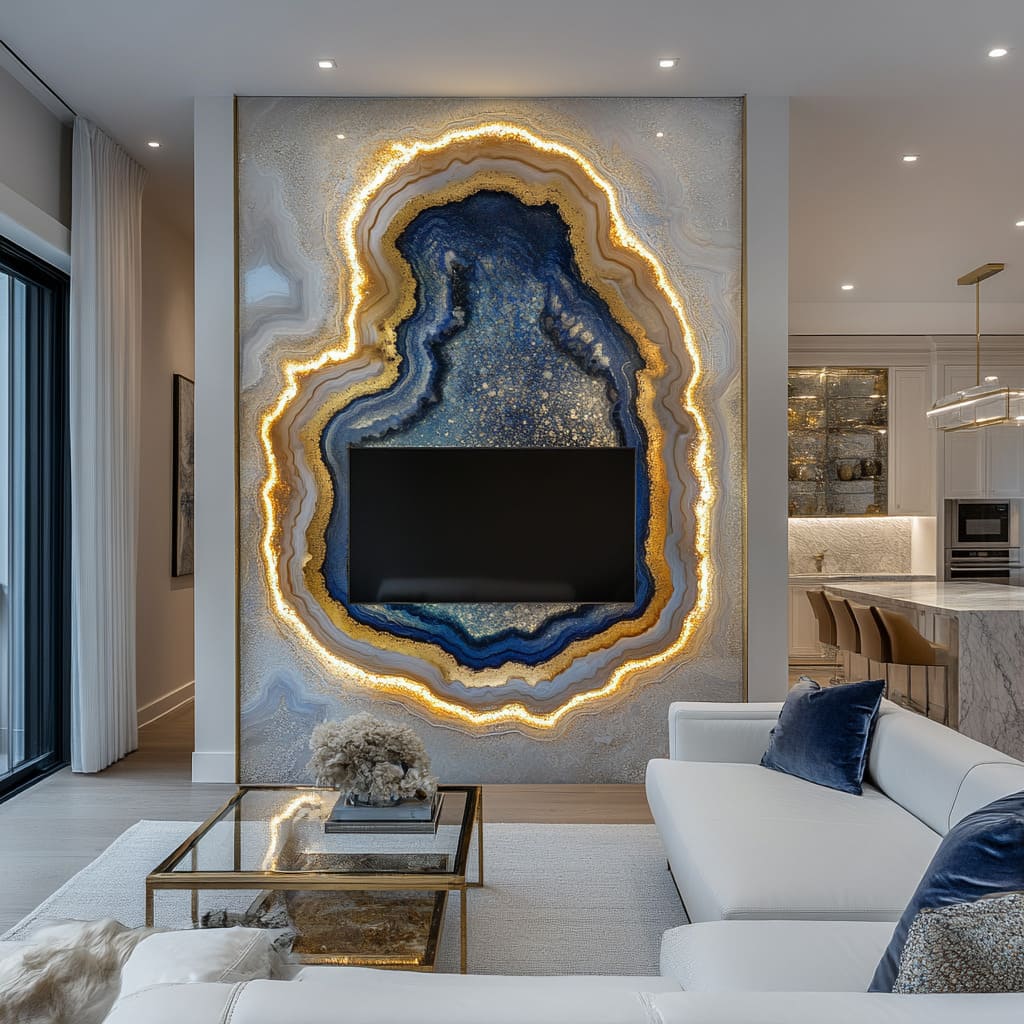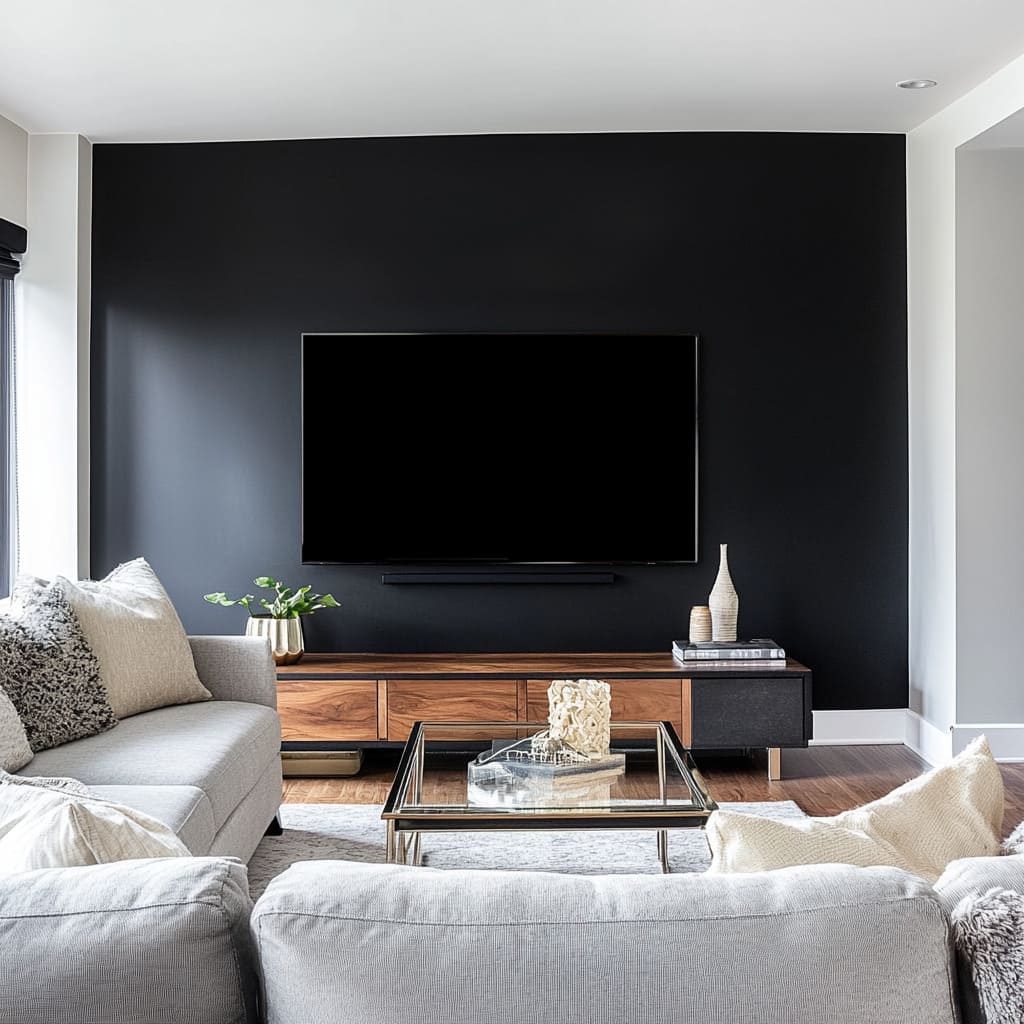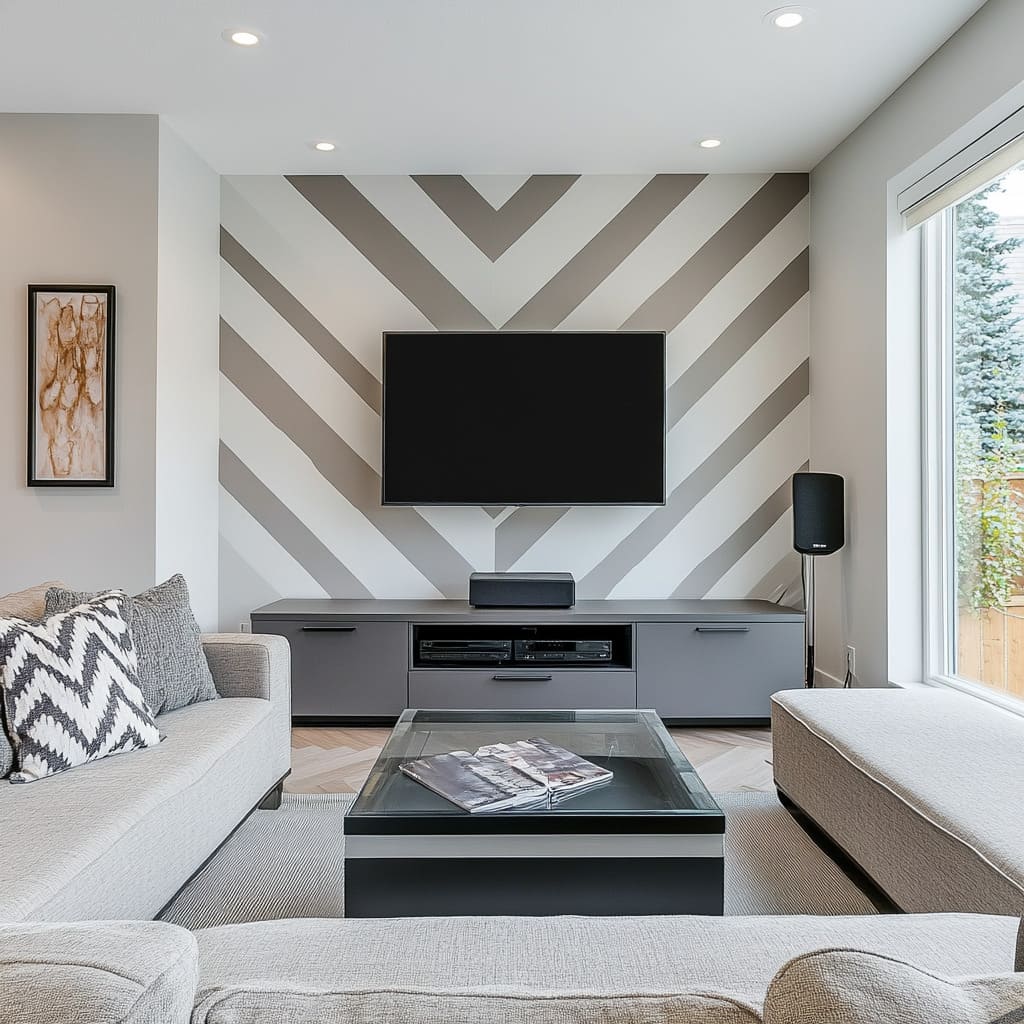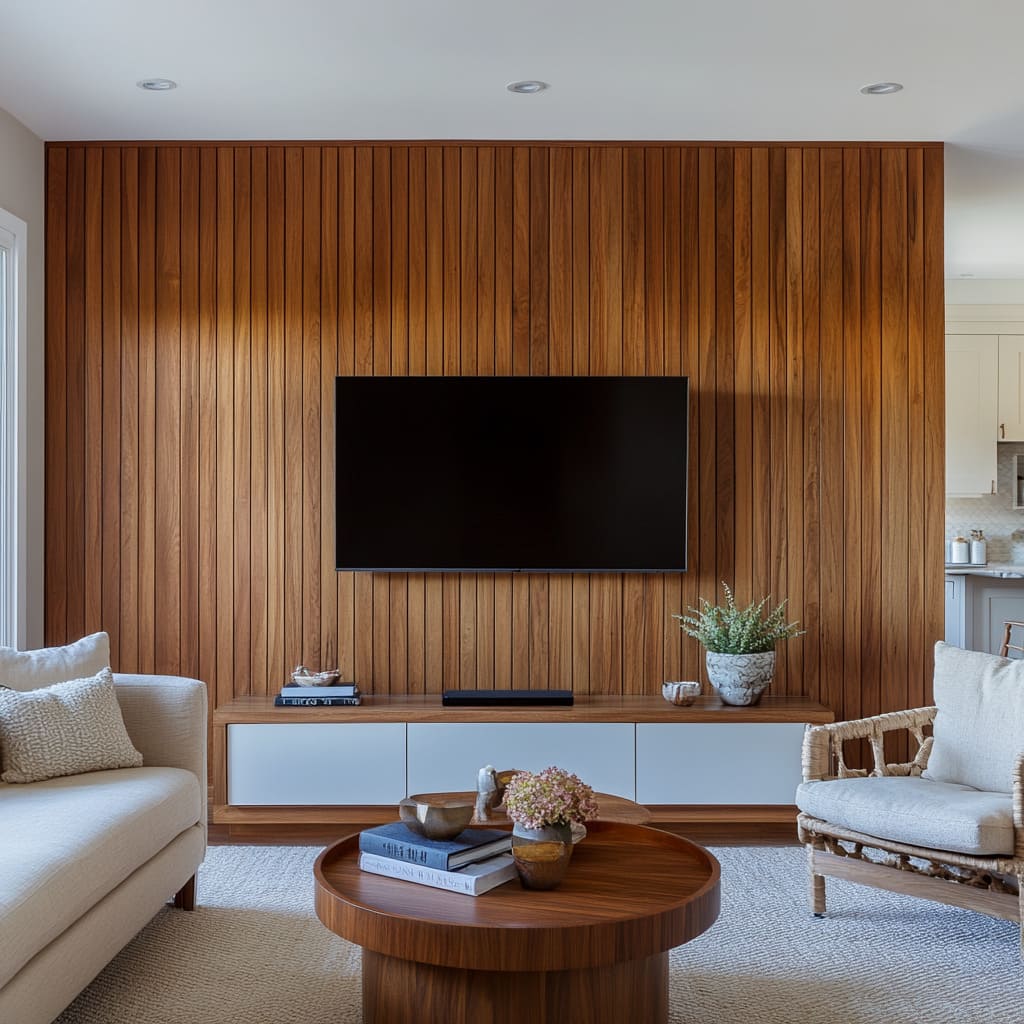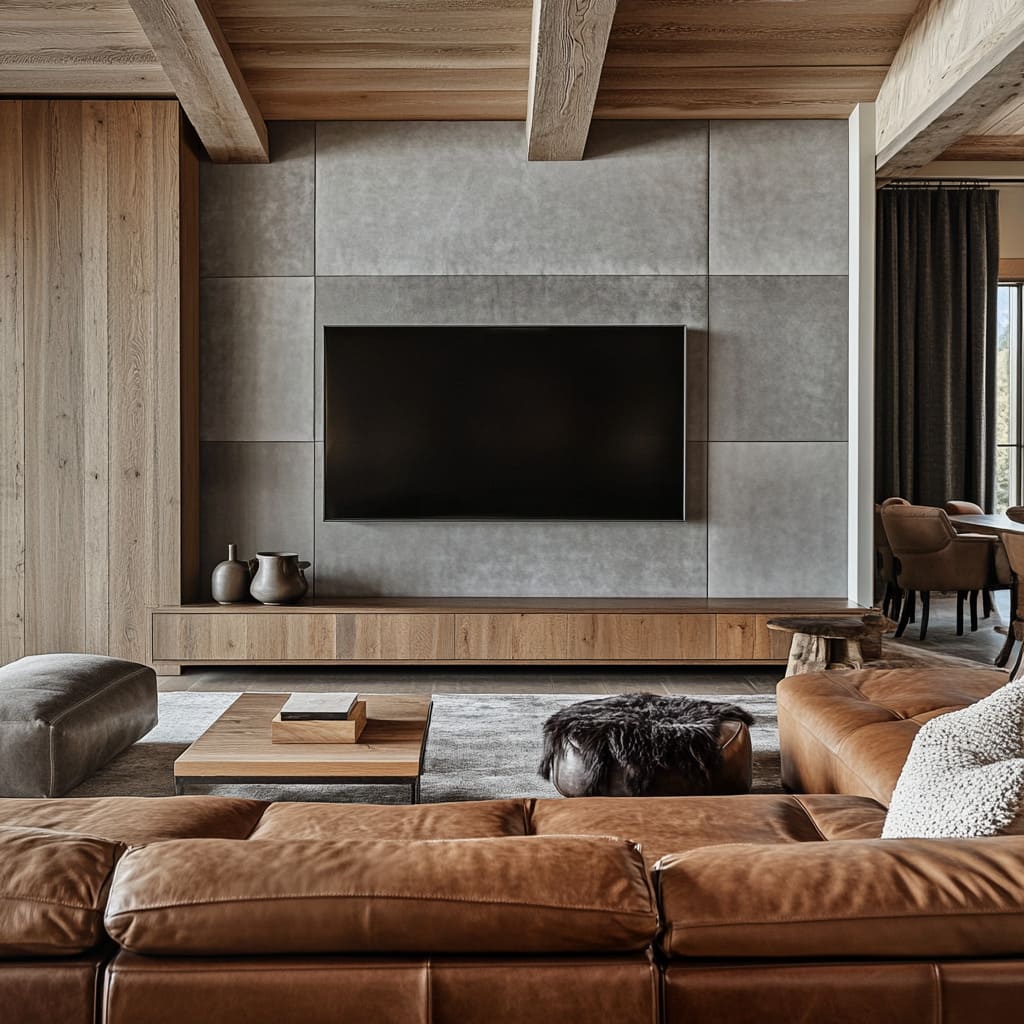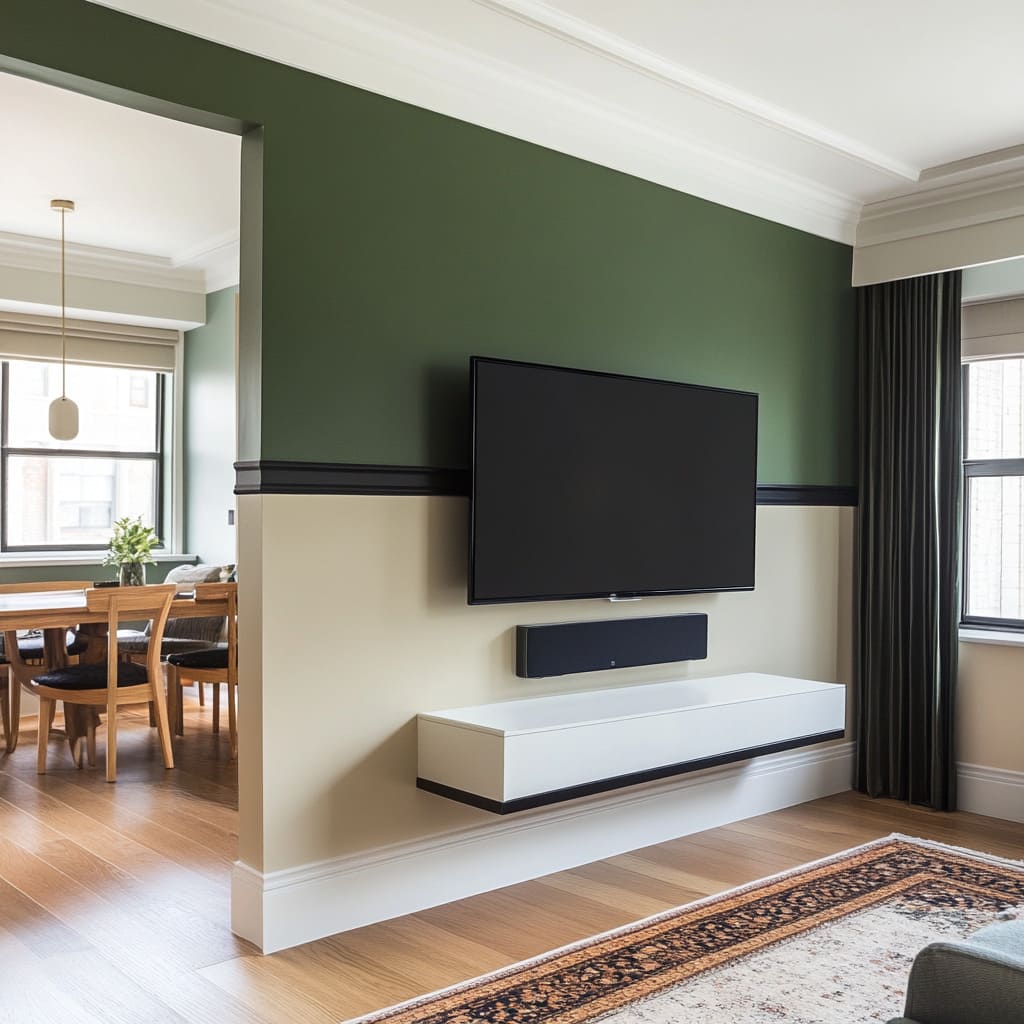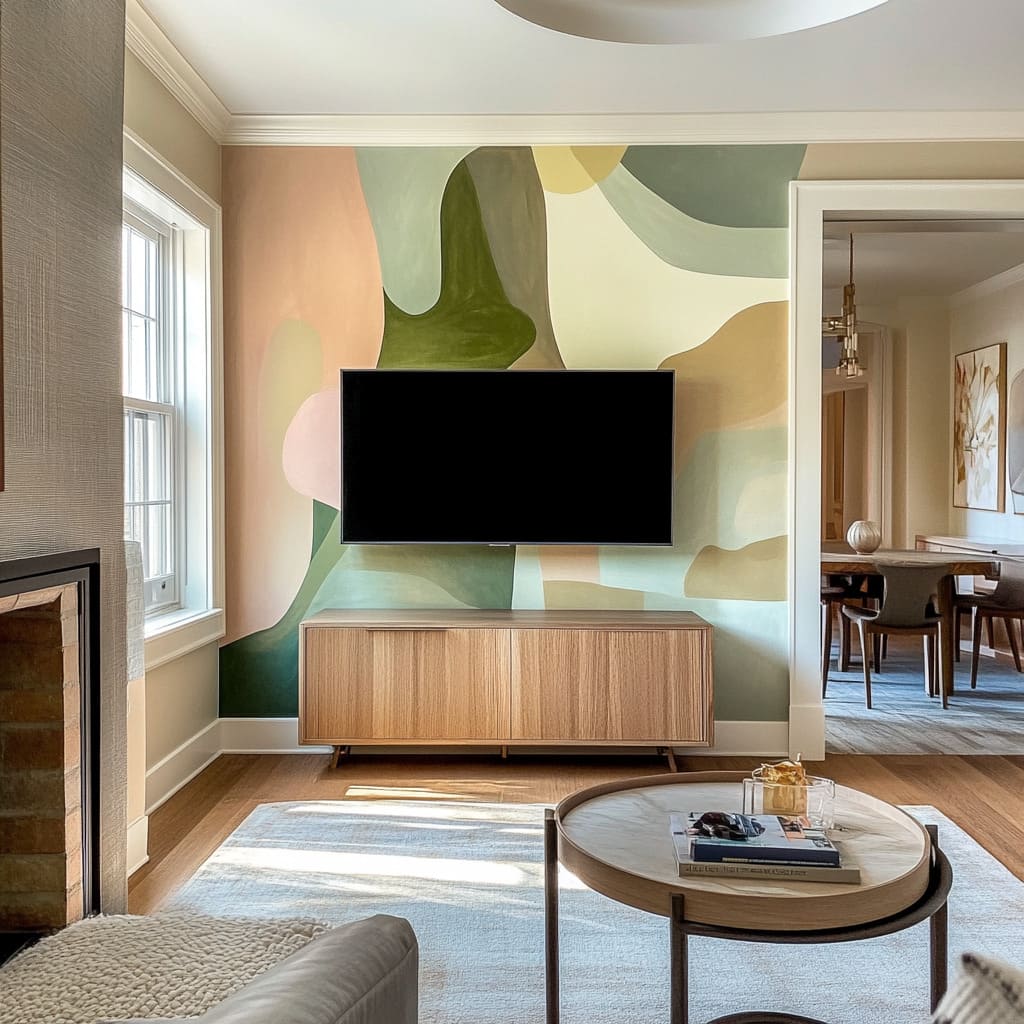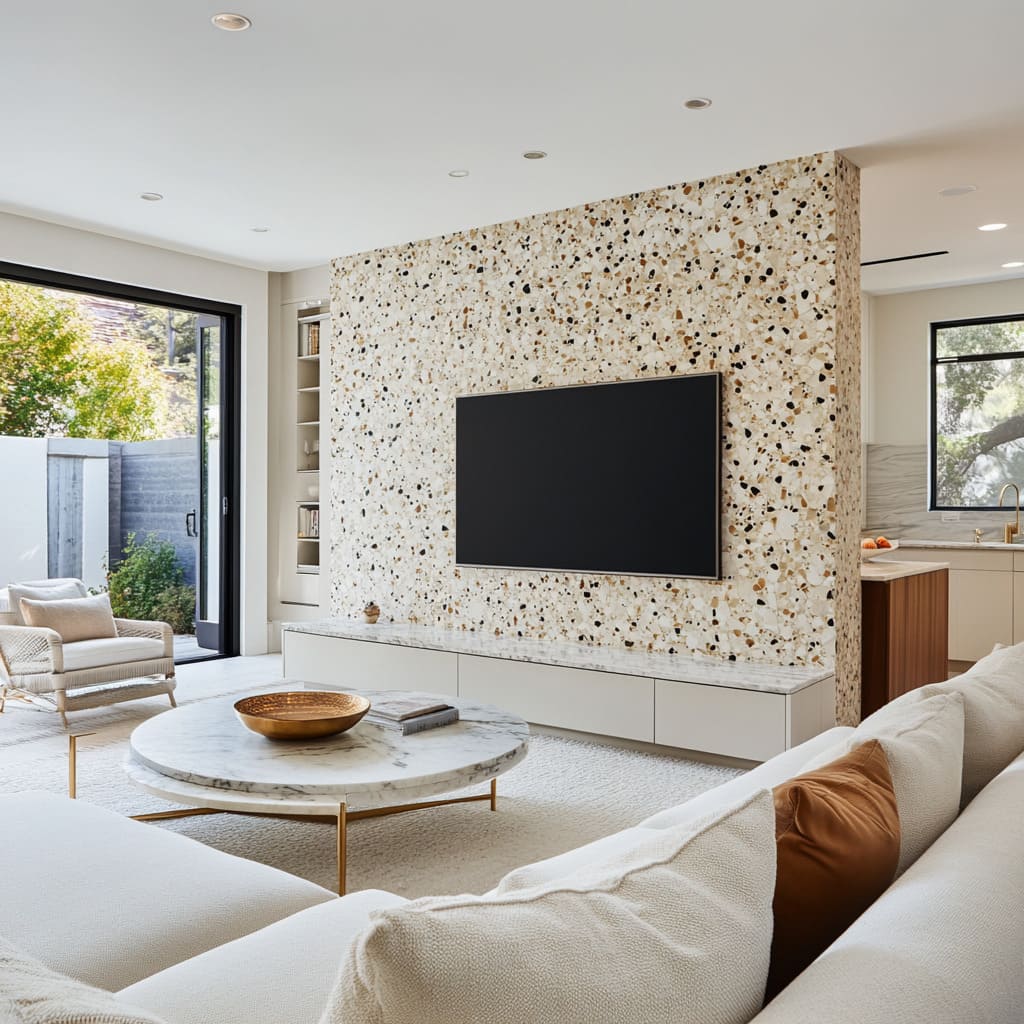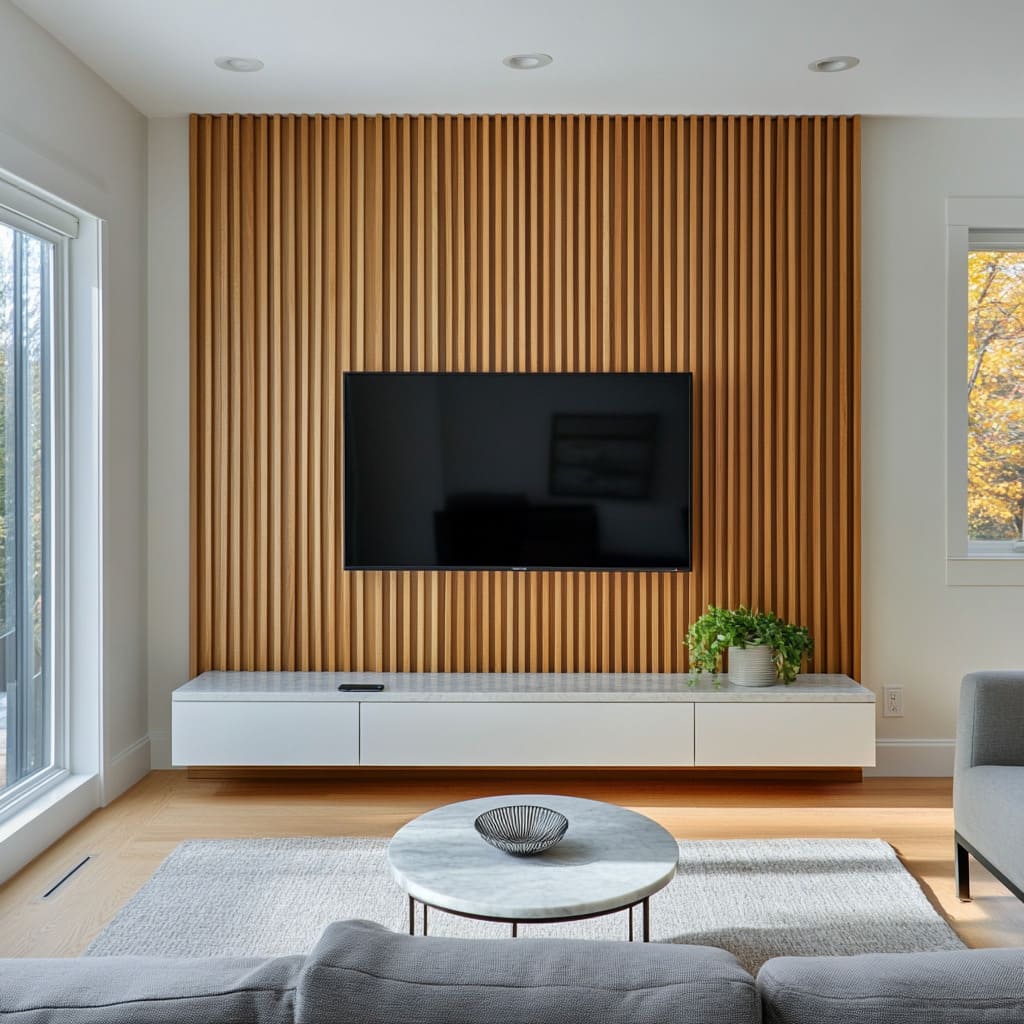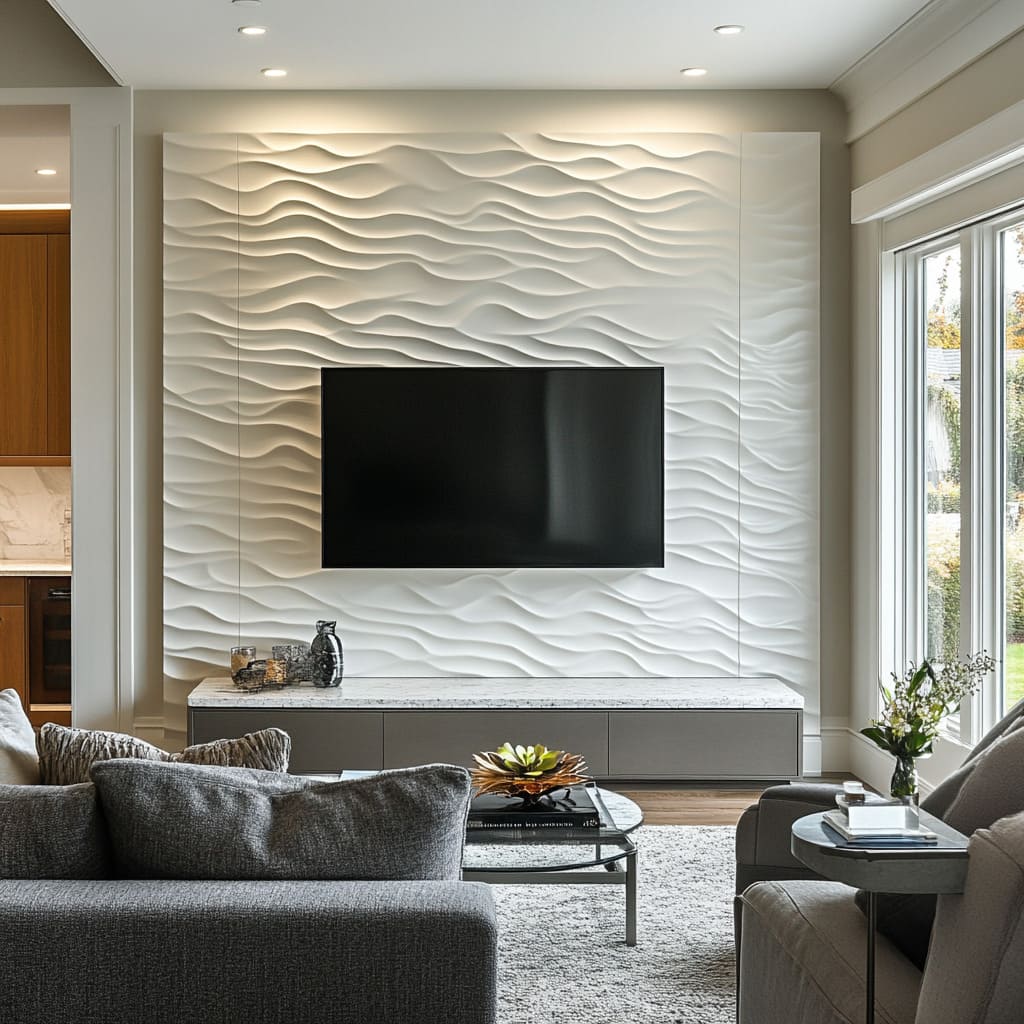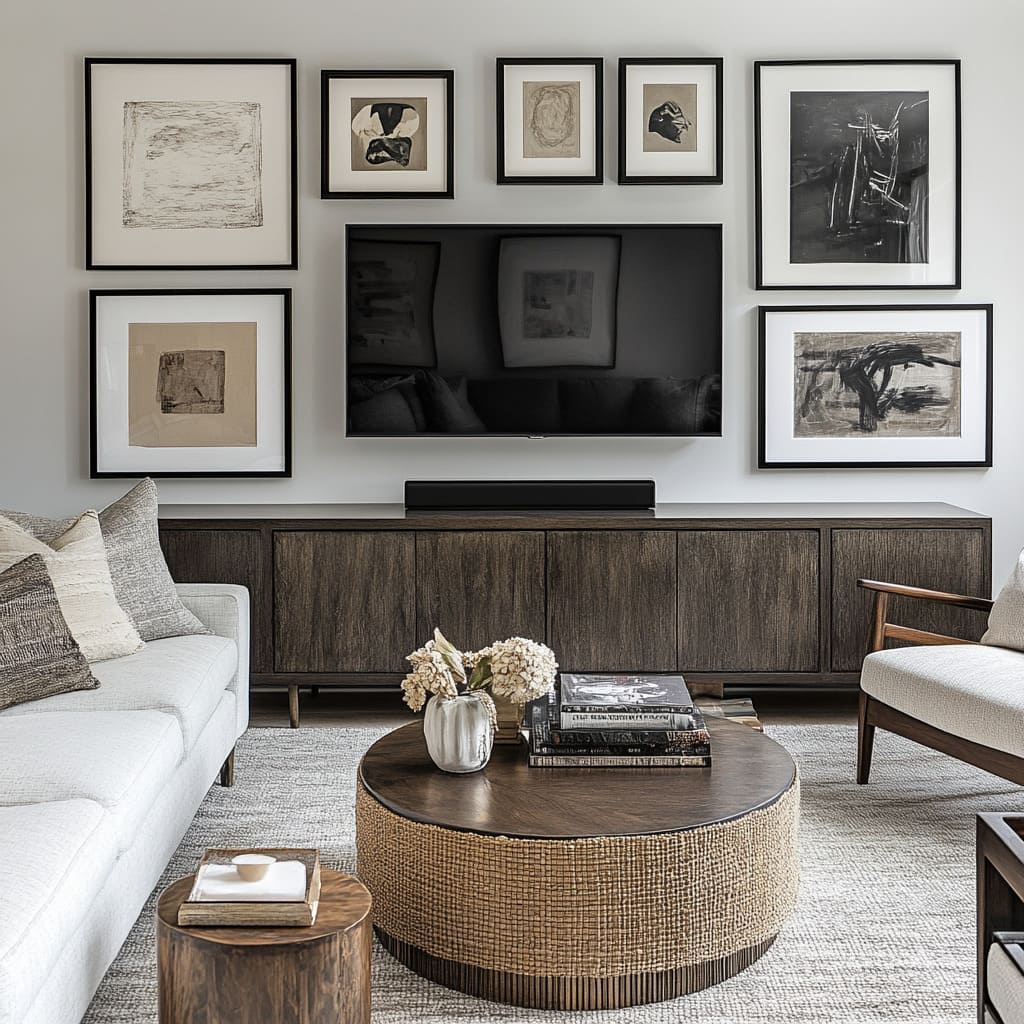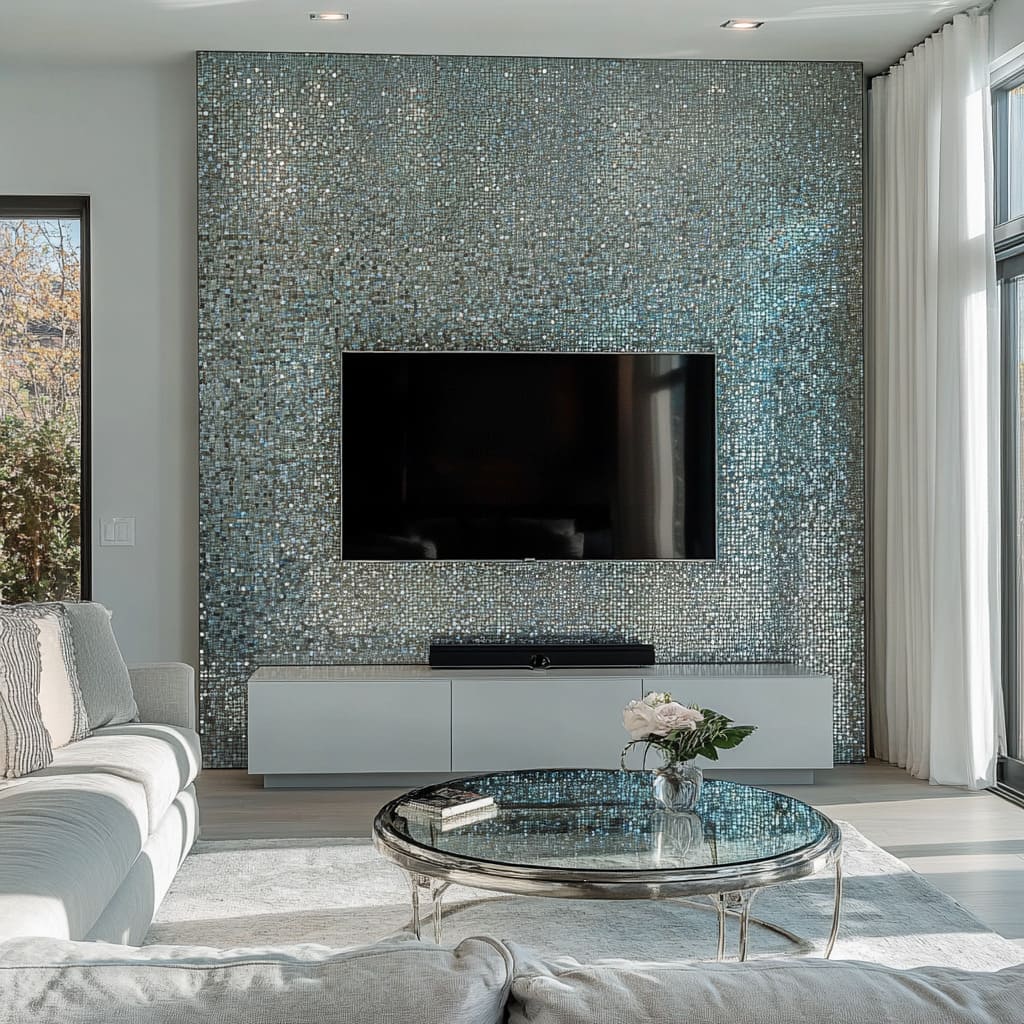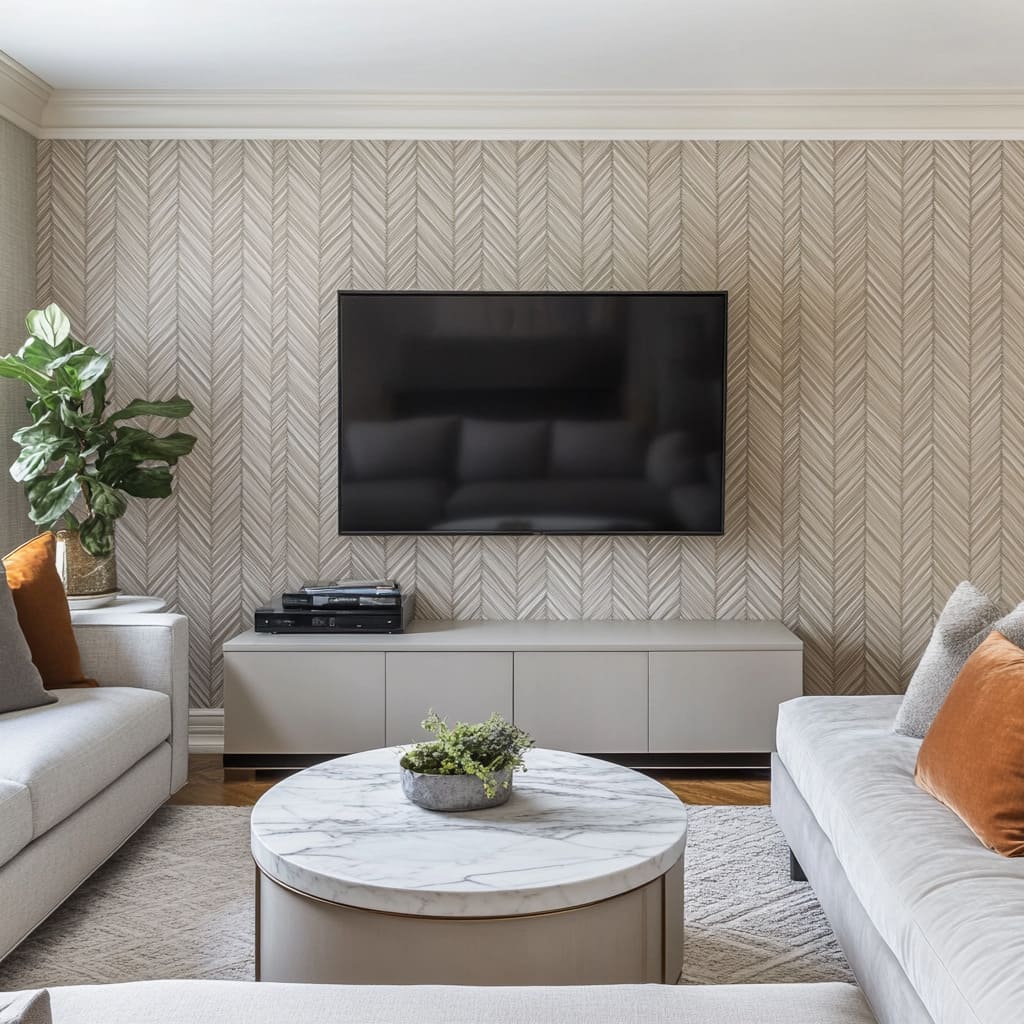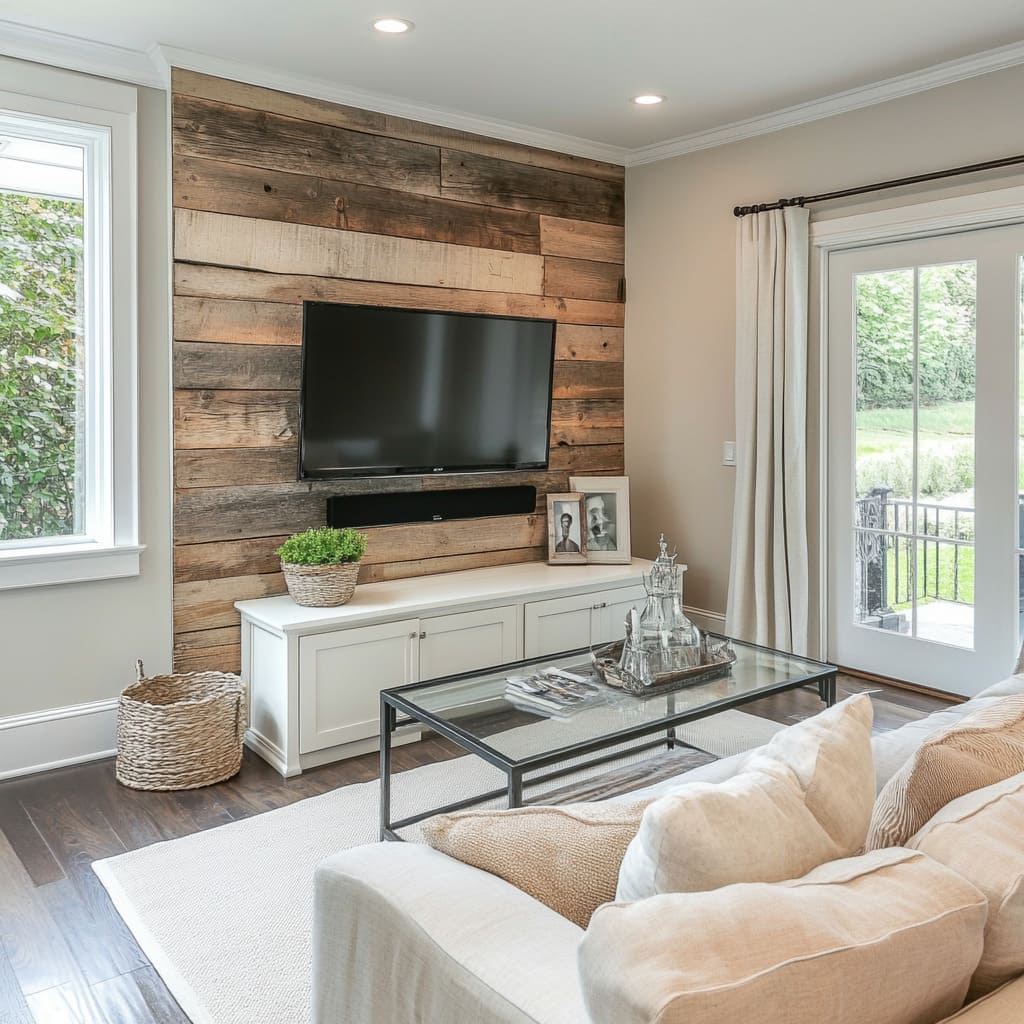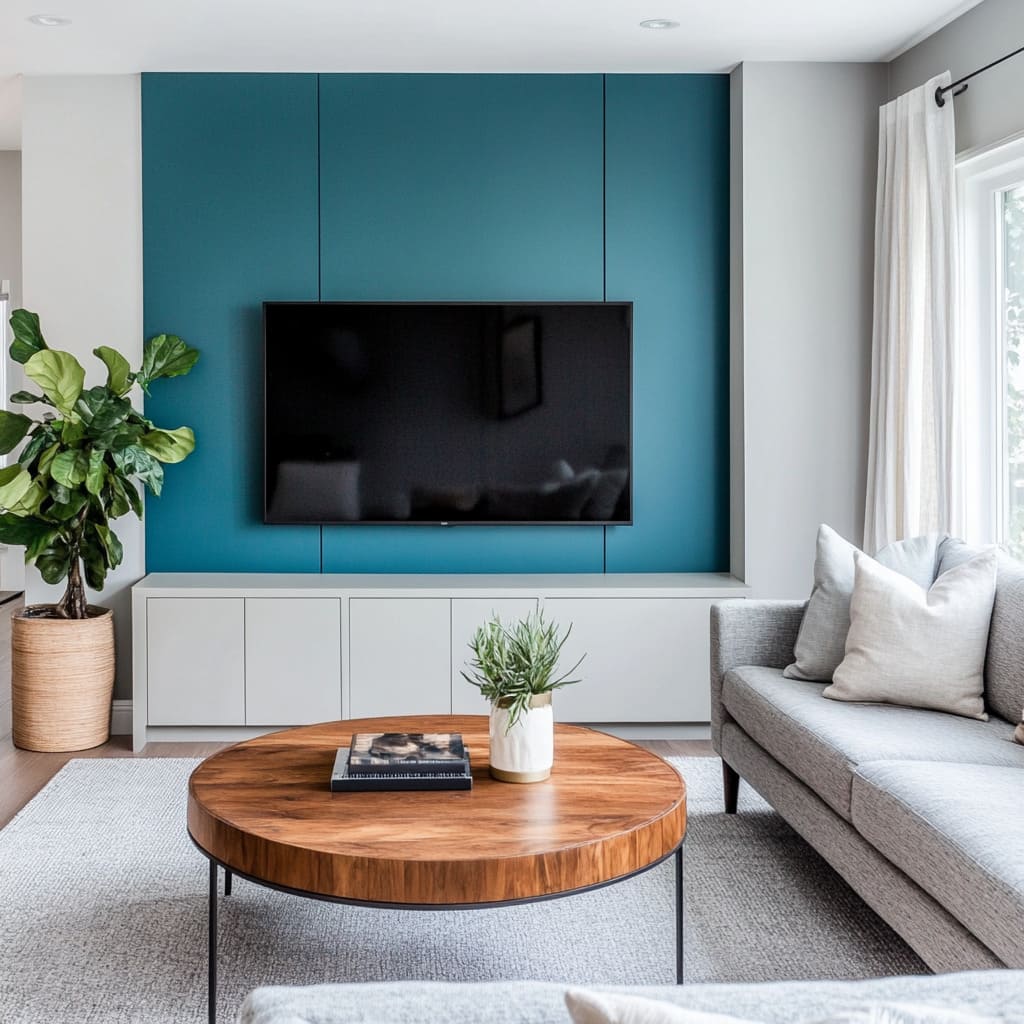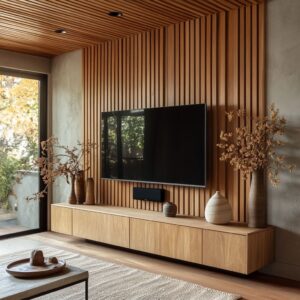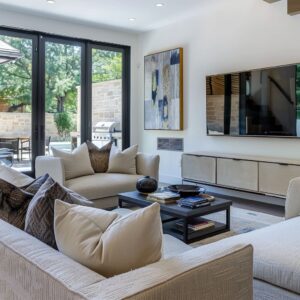In recent years, living rooms have shifted from being just a place for relaxation to becoming a showcase of personal style. One area that’s been getting special attention is the TV wall.
No longer just a plain surface to hang a screen, the TV wall is now a design feature in its own right. Homeowners and designers are using accent walls to give this area a bold, visually interesting look, transforming it into a statement piece.
Whether through textures, colors, or creative materials, accent walls can elevate the living room’s overall aesthetic, ensuring the TV is framed by something far more striking than a blank wall.
Choosing to invest in accent wall ideas can do more than simply decorate the space—it can redefine how the TV area fits into the broader design of the living room. It’s about turning a functional spot into something stylish, making the room feel cohesive and intentional.
A cohesive design in the living room is important, especially in today’s open floor plans where spaces often flow into one another. Without careful consideration, the TV area can easily feel disconnected or like an afterthought.
This is where accent walls come into play. By carefully selecting colors, textures, or patterns, the TV wall can become an anchor point in the room, adding depth and style without taking over the entire space.
The right accent wall can balance the practical need of a TV with the aesthetic goals of the room, ensuring the focus is not just on the screen, but on how the area enhances the design around it.
An accent wall also opens up countless feature wall ideas, from sleek and modern styles with geometric patterns to more organic designs using natural materials like wood or stone. The key is to ensure that the accent wall supports the overall theme of the living room, blending seamlessly with furniture, flooring, and other decorative elements.
This approach turns the TV wall into an integrated part of the space, not just a place to hang electronics.
Incorporating accent walls is about more than visual appeal—it’s about design balance. With the right accent wall, the TV becomes part of a larger design story, enhancing the room’s overall harmony.
Choosing the Right Materials for Your TV Accent Wall
Texture and Depth:
The materials you choose for your TV accent wall have a significant impact on the overall ambiance of the room. A plain wall can easily be transformed into a bold statement by adding texture and depth.
For instance, natural wood panels can bring a cozy, organic feel, while mosaic tiles introduce a dynamic surface that reflects light in subtle ways. Glass tiles, with their glossy finish, can create a sleek, modern look, particularly when illuminated by soft lighting.
Terrazzo is another material worth considering for its unique blend of colors and stone chips, offering a playful yet elegant touch to the space. These materials don’t just cover the wall; they interact with the light, the furniture, and the TV itself, making the wall a vital part of the room’s overall feel.
Texture is particularly important when considering the interplay between the TV and the surrounding space. A textured accent wall naturally draws attention, and depending on the choice of material, it can either blend harmoniously with the TV or contrast it in a striking way.
For example, a TV mounted on a reclaimed wood accent wall instantly adds warmth and depth to the room, making the technology feel more integrated with the living space rather than standing apart from it.
Natural vs. Modern Materials:
When thinking about accent wall living room ideas, the choice between natural and modern materials plays a critical role. Reclaimed wood is a popular natural option that brings character and a sense of history to the room.
It offers an earthy, grounded feel, and because no two pieces are exactly alike, it adds uniqueness to your living space. This material pairs beautifully with neutral furniture and can make a modern living room feel more inviting.
On the other hand, modern materials like metallic finishes or sleek glass tiles offer a different kind of aesthetic—one that is polished, reflective, and more in line with contemporary design. Glass tiles in particular have a sophisticated appeal, often chosen for their ability to reflect light, which can make the room feel larger and brighter.
Balancing Texture and Simplicity:
With so many rich textures available, it’s easy to get carried away, but balance is crucial. While bold textures like 3D panels, reclaimed wood, or intricate mosaics can make an accent wall visually striking, pairing them with clean lines in the surrounding furniture or the TV unit itself prevents the space from feeling too busy.
For example, a wood-panelled wall can shine next to a minimalist TV console or sleek modern furniture, creating a balance between complexity and simplicity. This ensures that the accent wall serves as a focal point without making the room feel cluttered.
When planning your accent wall design ideas, remember that simplicity in other elements of the room can help accentuate the textures of the wall. Whether using modern, smooth materials or organic, rough finishes, keeping the furniture and décor minimal and cohesive allows the accent wall to be the star of the show.
With the right balance, your TV wall won’t just be a background; it will be a key player in shaping the room’s identity.
Play With Color to Elevate Your Accent Wall
Bold and Dramatic Hues:
If you want to make your TV area a true focal point, bold, dramatic colors are a great place to start. Deep, rich hues like teal, forest green, or navy instantly create a striking backdrop that draws attention to the TV without needing any additional decor.
These darker tones provide an excellent contrast to the sleek, often black or metallic, finish of a TV, helping it feel more integrated into the overall design. For modern living rooms, where minimalism and clean lines often dominate, dark colors help ground the space, giving it a sense of depth and sophistication.
Using these bold colors for accent walls behind TV can also anchor the entire room. In larger spaces, these hues prevent the wall from feeling too expansive, while in smaller rooms, dark tones can actually make the space feel more intimate and cozy.
Pairing a dark accent wall with light furniture and minimal decor creates a balanced aesthetic that feels modern yet welcoming. The key is to let the color work for you, enhancing the visual impact of the TV area without overwhelming the space.
Neutral Tones with Intriguing Patterns:
For those who prefer a subtler approach, neutral tones like beige, soft grey, or cream are timeless choices that can add elegance without stealing the spotlight. But to keep the design from feeling too plain, pairing these neutral shades with intriguing patterns like herringbone or chevron is a perfect way to add interest.
These patterns can introduce texture and movement, turning what might have been a simple background into a stylish feature.
A neutral-colored feature wall with TV ideas can achieve a delicate balance—offering just enough design to make the TV area pop without being overpowering. Patterns like herringbone wallpaper or textured tiles offer subtle detail, making the TV wall more visually engaging while keeping the overall palette light and airy.
This approach is particularly well-suited for smaller spaces or rooms with abundant natural light, as the lighter tones can reflect light and make the space feel open, even with intricate designs.
Two-Tone Designs for Subtle Impact:
If you’re looking to add dimension and color without overwhelming the room, a two-tone wall might be the ideal solution. Two-tone designs involve dividing the wall into two sections, each painted in a different shade.
This technique allows you to create a subtle but dynamic effect, visually separating the TV zone from the rest of the wall. It’s a clever way to incorporate color into the space while maintaining a clean and modern aesthetic.
For instance, you can choose a darker shade like navy or charcoal for the bottom half of the wall, with a lighter tone such as pale grey or white for the upper section. The contrast between the two colors creates a striking visual boundary that can make the TV feel framed and defined.
This works especially well when the dividing line is placed just behind the TV, offering a clear separation between the screen and the rest of the room. Two-tone accent walls behind TV are an understated way to add character, especially in minimalist spaces where simplicity reigns.
This technique is not only visually interesting but also flexible. You can experiment with various combinations of colors, from bold contrasts to more subtle transitions, depending on the look you’re going for.
It’s a simple yet effective way to add personality to your TV wall while keeping the overall design polished and sophisticated. By experimenting with bold hues, intriguing patterns, or two-tone color schemes, you can transform your TV wall into a stylish feature that enhances your living room’s overall design.
Whether you’re going for a daring or subtle effect, these color strategies ensure your TV area stands out while maintaining balance within the space.
Adding Visual Interest Through Patterns and Shapes
Geometric Patterns:
One of the most effective ways to create a visually dynamic TV accent wall is through the use of geometric patterns. Designs such as chevron and herringbone offer a stylish and structured aesthetic that can elevate the overall feel of a room.
These patterns bring order to the space, especially when paired with clean, modern furniture. A chevron design, for instance, can guide the eye toward the TV, subtly framing it while adding depth and interest.
The repetitive lines found in these patterns also introduce a sense of balance and symmetry, which can make the entire space feel more cohesive.
Geometric patterns aren’t just about adding flair—they are also about enhancing the overall visual architecture of the room. For a modern twist, mixing muted colors or natural tones within these patterns can keep the design sophisticated while still allowing it to serve as a focal point.
This approach to TV accent wall ideas ensures that the wall doesn’t overpower the room but instead creates an organized, stylish frame for your entertainment space.
Organic and Abstract Designs:
In contrast to the clean, structured look of geometric patterns, organic and abstract designs introduce a more freeform, artistic vibe to your living space. Using accent walls with curved shapes or abstract murals can make the TV area feel less rigid and more creative.
These types of decorative wall ideas for living room bring a unique playfulness that can either soften a room’s edges or add a touch of whimsy to an otherwise minimal design. For example, murals featuring soft colors and sweeping curves not only emphasize the TV as a central element but also transform the entire wall into a visual masterpiece.
Abstract designs work exceptionally well in homes where art and creativity play a big role in the decor. Unlike geometric patterns, which may feel more structured, organic shapes introduce flow and fluidity.
This approach makes the accent wall serve both as a background for the TV and as an artistic expression in its own right. Whether it’s a soft, pastel mural or a bold abstract piece, these designs offer versatility and a sense of playfulness that brings life to the room.
3D Sculpted Panels:
For those looking to make a bold statement, 3D sculpted panels are an excellent option for adding texture and movement to a TV wall. These panels, which often feature undulating shapes or wave-like designs, create a sense of depth that flat walls simply can’t achieve.
By introducing these elements, you can transform the TV wall into more than just a functional area—it becomes a true focal point that adds layers to the room’s overall design.
These living room ideas with accent walls allow homeowners to experiment with light and shadow, as the sculpted surfaces catch and reflect light throughout the day. Panels with waves or other organic forms are particularly effective at creating a calm yet dynamic backdrop for the TV, adding an extra dimension that invites attention without feeling overpowering.
The result is a wall that stands out for its intricate texture and provides an elegant contrast to the sleek, flat surface of the television. These sculpted designs turn what could be an ordinary wall into a feature that enhances the entire living space.
Incorporating Lighting to Enhance the Accent Wall
Backlighting and LED Integration
Incorporating lighting into your accent wall can dramatically change the atmosphere of your living room, particularly when used around textured or reflective materials. One of the most impactful methods is backlighting, which involves installing LEDs behind specific sections of the wall.
This technique works exceptionally well with 3D panels or glass tiles, adding depth and making the surface appear to glow softly. Backlighting not only highlights the unique textures but also draws the eye toward the TV, framing it in an understated yet captivating way.
For those who want to take this idea further, integrating programmable LEDs that change colors based on mood or time of day can add a customizable dynamic to the space. These lights can emphasize specific materials—such as glass mosaics—by creating reflective effects that shimmer with each color change.
The versatility of LED lights makes it easy to adjust the feel of the room without altering the overall design. When paired with materials like reflective tiles or sculpted panels, this lighting approach can transform even simple TV feature wall ideas into a dramatic visual centerpiece.
Natural Light Reflection
Not all accent walls rely solely on artificial lighting to create impact. Some materials are naturally reflective, bouncing light around the room and making the space feel brighter and more open.
This is especially valuable in rooms that don’t have large windows or ample natural light. Glass mosaic tiles, for instance, work brilliantly in such settings.
Their glossy surfaces catch and reflect sunlight, adding a sense of depth and airiness to even the smallest spaces.
Terrazzo is another material that works well in this context. The blend of natural stone chips within the material can subtly reflect light, giving the wall a multifaceted appearance that shifts as the light changes throughout the day.
This approach to accent wall ideas for a living room ensures that the TV area doesn’t just blend into the background but becomes a vibrant feature that interacts with the natural light in the room. When strategically placed near windows or sources of light, these reflective materials can amplify the brightness of the space, creating a more inviting and spacious environment without relying solely on artificial illumination.
By using these lighting techniques, both artificial and natural, you can ensure that your TV accent wall is not just functional but also enhances the overall aesthetic of your living room, creating an atmosphere that is both engaging and visually dynamic.
Accent Wall Ideas for Different Living Room Styles
Rustic and Cozy Living Rooms
For those who love the charm of a farmhouse or cottage-style living room, reclaimed wood or natural stone can bring warmth and texture into the space. The irregularities in reclaimed wood, with its visible grain and knots, create a lived-in, welcoming atmosphere that makes any room feel instantly cozier.
Pairing a TV with a wood accent wall can soften the sharp edges of modern technology, blending it seamlessly with the rustic feel of the room.
Natural stone is another excellent choice for a more earthy, grounded look. Whether it’s stacked stone or a smoother finish, stone brings a rugged texture that complements neutral color palettes often found in rustic homes.
A stone wall behind the TV can be a statement feature, especially in a room with high ceilings or exposed beams. By incorporating natural elements like these, you can create ideas for accent wall living room spaces that feel warm, welcoming, and full of character.
Modern and Minimalist Spaces
If your style leans more toward sleek, contemporary designs, simplicity and clean lines are key. Minimalist living rooms benefit from accent walls that emphasize structure rather than decoration.
A monochromatic palette of black, white, or grey works beautifully with smooth textures, like matte paint or polished concrete. These choices give the room a crisp, uncluttered feel, where every element has a purpose.
For modern living rooms, a wall idea for TV could include subtle textures like large-format tiles or panels that add depth without overwhelming the eye. Combining these materials with minimalist furniture helps maintain an airy, uncluttered aesthetic, allowing the TV to sit comfortably within the design without drawing undue attention.
The result is a modern, streamlined space where the accent wall provides just enough interest to elevate the room while keeping it sleek and functional.
Eclectic and Artistic Designs
For those with more adventurous tastes, eclectic or artistic accent walls offer endless possibilities. Think bold murals, abstract patterns, or even hand-painted designs that inject personality into the living room.
The key here is to let your creativity guide the design, choosing colors and shapes that resonate with your personal style.
Murals can transform a wall into a piece of art, making the TV area feel like an intentional part of the room’s design. Abstract shapes or geometric patterns, when used as an accent, can create a dynamic contrast to the sleekness of the television, offering a playful yet sophisticated backdrop.
This is especially appealing for eclectic interiors, where combining different styles, textures, and colors adds energy to the space. These wall ideas for TV are perfect for those looking to express their creativity, ensuring that the accent wall is as much a conversation piece as it is a functional feature.
By aligning your accent wall with the overall style of your living room—whether it’s rustic, modern, or artistic—you can ensure that your TV area enhances, rather than detracts from, the room’s design. Each style offers unique opportunities to transform a simple wall into something that truly makes a statement.
Balancing the TV with Other Design Elements
Furniture Placement and Size Considerations
When designing a living room with an accent wall that incorporates the TV, one of the first things to consider is how the size and placement of the television will interact with the rest of the design. An accent wall can draw attention, but you want to ensure that the TV doesn’t overshadow or clash with it.
The goal is to create harmony between the two.
A larger TV commands more visual space and can quickly dominate the room if not balanced with subtle wall treatments. In these cases, opting for neutral tones or minimalist textures—like matte-finish paint or smooth wooden panels—can help maintain a calm aesthetic.
This allows the TV to become a natural part of the room without overwhelming it. On the other hand, a smaller TV can get lost on a large wall if it’s not framed appropriately.
Here’s where you can afford to be bolder with your accent wall choices, such as integrating bright colors, geometric patterns, or eye-catching materials like textured stone or glass tiles.
Furniture placement is also key to making sure the TV complements, rather than competes with, the accent wall. Arrange seating so that the focal point remains the TV and wall without leaving any awkward gaps.
Low-profile consoles or floating media units can contribute to a more cohesive look, keeping the overall design grounded and functional. When the proportions between the furniture, TV, and accent wall are balanced, it creates a seamless flow in the room.
Integrating the TV into a Gallery Wall
For those seeking a softer approach that blends the TV into the decor, gallery walls offer a creative solution. Rather than having the television stand alone, surrounding it with framed artwork or photographs can make the wall feel like a well-curated feature of the room.
This approach works particularly well for anyone who wants to downplay the technology aspect and add more personal touches to the space.
By thoughtfully arranging pictures and art pieces around the TV, you can make it appear as just one element among many, rather than the dominant feature. Choose frames that complement the overall style of your accent wall to ensure a cohesive look.
For example, dark wooden frames can enhance the warmth of a reclaimed wood accent wall, while metallic frames may add shine to a modern space with glass or tile finishes.
This type of arrangement also allows for more flexibility with accent wall decorating ideas, enabling homeowners to mix textures, colors, and designs without overwhelming the space. The TV becomes part of the story, rather than the only focal point, which can elevate the overall aesthetic of the room.
This gallery-style setup works particularly well for those who prefer living room ideas with accent wall designs that integrate art and tech in a balanced, visually appealing way.
Incorporating the TV into a larger design framework ensures that it doesn’t feel like an afterthought but rather a well-considered piece of the overall look.
Practical Considerations for TV Accent Walls
Durability and Maintenance:
When it comes to choosing materials for your TV accent wall, the balance between aesthetic appeal and practicality is key. A material that looks stunning but demands constant upkeep may not be the best choice for a busy household.
For example, reclaimed wood can give your space a rustic warmth and charm that’s hard to replicate. However, it may require periodic care to prevent wear and tear, especially in homes with fluctuating humidity.
Dusting and occasional polishing may be needed to keep its character intact, but the payoff is a living room that feels cozy and natural.
On the other hand, if low maintenance is a priority, tiles might be your best bet. A tiled feature wall brings a polished, sleek look to your space while being incredibly easy to clean.
Whether you opt for glass mosaic tiles that reflect light or terrazzo for a more textured feel, these materials resist stains and are perfect for homes with children or pets. Unlike more porous materials, tiles won’t require sealing or refinishing, and a simple wipe down will keep them looking fresh.
This makes them a great option if you want to enjoy both beauty and convenience.
Fabric panels, which are growing in popularity for creating softer, more luxurious textures, also offer their own set of benefits. They add warmth and soundproofing to a room, ideal if your living space doubles as a home theater.
But it’s important to note that fabric panels can attract dust and require occasional vacuuming or steam cleaning. Choosing a fabric with a stain-resistant finish can help minimize upkeep while still giving your room that plush feel.
Cable Management and Storage Solutions:
One of the often-overlooked aspects of accent walls is the practical need for effective cable management. The cleanest and most stylish TV accent wall can quickly lose its appeal if it’s cluttered with visible wires and devices.
Therefore, planning ahead to integrate cable management systems is essential. Floating consoles or hidden shelving can keep all wires tucked away, leaving your wall streamlined and your living room free from visual distractions.
Incorporating built-in shelves or floating media units offers more than just a space to house your electronics. They can serve as part of the overall feature wall ideas for living room designs.
For example, a floating shelf in a matching or contrasting material to the accent wall can add a design element that doesn’t interfere with the overall look. Plus, these units help keep gaming consoles, sound systems, or other tech neatly organized, eliminating the clutter of external media units that could interfere with the design flow.
Additionally, when planning storage solutions, it’s wise to consider the future needs of your home. Whether you’ll add new devices or simply need extra room for decorative items, shelving can offer flexibility.
Many homeowners opt for built-in cabinets or console units beneath the TV, which can keep remotes, wires, and accessories out of sight, contributing to an organized and harmonious environment.
Ultimately, when designing your feature wall, thinking ahead about both durability and functionality ensures that your accent wall not only stands out in style but also serves the practical needs of everyday living. By choosing materials that align with your lifestyle and incorporating smart storage and cable management, you can create a TV area that is both visually stunning and functional for years to come.
Tips for DIY or Professional Installation
Simple DIY Accent Wall Projects:
For homeowners eager to tackle a DIY project, creating an accent wall can be a rewarding way to add personality and style to your living room without breaking the bank. One of the easiest DIY approaches is painting a two-tone wall.
This technique involves dividing the wall horizontally and painting each half in complementary colors. It’s a great way to create visual interest while keeping things relatively simple.
For example, choosing a darker color for the lower section and a lighter tone for the upper part can give your room a structured and sophisticated look. For those seeking living room accent wall paint ideas, a two-tone approach can be an easy yet impactful choice.
Peel-and-stick tiles are another accessible DIY option that delivers a polished finish without requiring advanced skills. Available in a variety of textures and colors, these tiles can mimic everything from rustic wood to sleek modern stone.
The best part is that you can install them with minimal tools and expertise. Just be sure to properly prep the wall by cleaning and smoothing the surface to ensure the tiles adhere properly.
For a more polished look, use a level and spacing tools to keep the alignment even. These materials are ideal for accent TV wall ideas, offering a high-impact design without the need for grout or complicated installations.
Another easy DIY project is adding molding or board-and-batten designs. This can give your wall a more custom, architectural feel with just a few basic tools like a miter saw and a nail gun.
The key to pulling off any DIY project, though, is attention to detail. Measure carefully, use painter’s tape for clean lines, and take your time with each step.
A polished, professional look is achievable, even with DIY methods, as long as you maintain precision.
When to Hire a Professional:
While DIY projects can be satisfying, there are times when it’s worth considering a professional for more complex accent wall installations. For example, installing intricate mosaic tiles or 3D wall panels requires a level of expertise that goes beyond simple peel-and-stick methods.
Mosaic tiles, with their detailed patterns and grout lines, demand precise placement to ensure that the design remains cohesive and balanced. Without the proper tools and experience, DIY attempts can quickly become overwhelming.
3D panels, another visually stunning option, require careful planning and often involve cutting custom pieces to fit around outlets, corners, or windows. This level of complexity is best left to professionals who have experience ensuring that all elements align perfectly.
In these cases, hiring a skilled contractor can save you time and frustration while ensuring a flawless finish that looks high-end and enduring.
Another area where professional installation is highly recommended is with built-in shelving or custom cabinetry surrounding the accent wall. These installations require carpentry skills to achieve the perfect fit and finish.
A poorly executed installation can detract from the overall design, whereas a professional job adds value to your home and can elevate the entire room.
If your accent wall involves complicated lighting setups, such as backlighting for glass panels or LED integrations, a professional can ensure the wiring is done safely and effectively. These lighting elements can take a feature wall from beautiful to breathtaking, but they also require technical expertise to avoid electrical issues down the line.
In summary, while many accent TV wall ideas can be tackled by a DIY enthusiast, more intricate designs or installations that involve multiple materials, custom fittings, or lighting are best left to professionals. Knowing when to call in an expert ensures that your accent wall becomes a standout feature in your home, not a source of ongoing frustration.
Conclusion
A thoughtfully designed accent wall can completely transform the look and feel of your living room, making the TV area not just functional but an eye-catching centerpiece. By playing with textures, colors, and patterns, you can add depth and character to a space that might otherwise be overlooked.
Whether you choose warm wood tones, sleek tiles, or bold colors, an accent wall has the power to elevate the entire room’s design. With the right combination of living room accent wall colors, materials, and textures, you create a backdrop that complements the TV without overwhelming the space, bringing both balance and style into your home.
Accent walls offer endless opportunities for creativity, allowing you to reflect your personal style while enhancing the room’s overall aesthetic. From simple two-tone walls to more intricate feature wall designs, the possibilities are vast.
By focusing on the TV area, you can make it a cohesive part of your living room’s design, turning what is typically a practical space into one that feels intentional and beautifully integrated.

